




Global experts will gather in Coventry on the 9th and 10th July 2018 to discuss all the key topics surrounding CAVs and Future Mobility. Many of the speakers and sponsors of the conference have contributed to this special show issue of the TaaS Technology Magazine.
Technology is more deeply affecting the future of mobility than any time since the birth of the automobile. Gain key insights into forces shaping transportation’s future through TaaS Magazine and at the TaaS Technology conference.
The era of the autonomous vehicle is here. According to industry estimates, by 2020 the autonomous vehicle market will be worth (USD) $87 billion. Furthermore, by 2040 it is predicted that four out of every 10 vehicles on the road will be autonomous. Autonomous vehicles will create new opportunities and an impetus for organisational innovation across a wide range of industries.
Today's economies are dramatically changing, triggered by development in emerging markets, the accelerated rise of new technologies, sustainability policies, and changing consumer preferences that include how people view the need for vehicle ownership. Digitisation and new business models have revolutionised other industries, and transportation will be no exception. For the automotive sector, these forces are giving rise to four disruptive technology‐driven trends: diverse mobility, autonomous driving, electrification, and connectivity.
Issue 2 of TaaS Technology magazine welcomes contributions from Ricardo, PTV Group, Nokia, BMW, Vulog, WMG at the University of Warwick amongst many more. Some of our contributors will be attending and speaking at TaaS Technology conference and we can’t wait to welcome the global CAV and Future Mobility community to the conference.
The TaaS Technology Conference will bring together international experts for two days of in-depth discussions and exhibits focused on the opportunities and challenges of a mobility future that leverages CAVs and TaaS technologies.
The event will span 2 days, cover 11 key topics and have over 40 presentations as well as interactive panel sessions, featuring industry titans, noted thought leaders and experienced entrepreneurs.
We asked James Carter from Vision Mobility, who is a co-chair, program board member and speaker at the conference to share his thoughts.
“Though I have been working in Automotive for more than 20 years, today is easily the most exciting time that I have experienced. Why? Because not just automotive, but all of transportation, is on the verge of a revolution that will result in the greatest change in more than 100 years. The future technologies centred around CASE – Connected, Autonomous, Shared, Electric – mashes together the previously very siloed transportation industries into one big “Mobility” industry, and the platform that will carry these technologies is TaaS – Transportation as a Service.”
“That’s why the TaaS Technology conference in Coventry on the 9th and 10th July is so important. It brings together a diverse group of industry experts and begins to shine a light on the many different and diverse areas of mobility and how they fit together in an integrated mega-industry. I’ve been involved with the TaaS Technology team as an advisory board member and the level of knowledge that has been assembled is truly impressive. I’m also very much looking forward to being one of the conference chairs and listening first-hand about the potential impact of TaaS on our future mobility. I hope you can join me soon to discover how TaaS and future mobility will change not just our transportation, but the way we live our lives.”
We hope you enjoy issue 2 and with less than 3 weeks left to book your place and less than 20 delegate tickets left – we hope to welcome you to the TaaS Technology conference on July 9th and 10th. The conference is the must attend conference for the CAV and Future Mobility industry.
We're thrilled to be bringing the global CAV and Future Mobility community to Coventry, UK and we hope you can make it.
Book your place today. We have opened up 5 complimentary tickets for TaaS Technology Magazine readers, available on a first come first served basis. Please register here https://taas.technology/register and use the promo code TAASMAG for a 100% discount to be applied.
Mobility as a Service today seems to be mostly about convenience though the underlying safety benefits should not be ignored. There is significant interest in being able to arrange taxi services via smart phones and have personal goods delivered almost on demand. Ricardo share their thoughts with TaaS Technology Magazine.
This has led to major business opportunities and establishment of new companies like Uber and Didi. The size of the market is already staggering with claims that there are over 40M rides per day globally for ride hailing services. One wonders where this mobility revolution will lead to in the future. Ricardo is actively researching future potential scenarios for transportation from a societal impact and a commercial automotive industry basis. As well as defining the future scenarios, Ricardo is analysing the technical and commercial barriers and enablers, the likely timeframe for the scenario’s to mature and the attribute challenge of replacing the human driver with some form of AI. One particular scenario is a fully autonomous world where there is wide spread availability and usage of new mobility bikes, driverless pods, robotic taxis, trains and short trip aircraft/drones. This scenario has the potential to manifest in major cities, where travel is mostly short range for commuting, shopping, and entertainment, and is driven by convenience and accessibility for all. Transportation services can also be very affordable and end up replacing personal car ownership. Although it should be noted this is just one scenario for the future, it is worth exploring the opportunity and implications for this future because it could be so disruptive to today’s automotive industry.
Mobility in a fully autonomous world will be radically different to today’s modes which is mostly based on personal car usage. In the automated and connected world, we will be able to plan and book our trips using apps on our smart phones, tablets or even internet connected wearables. This will allow multi-mode travel options from autonomous specialty cars to public transit to passenger drones to airplanes.
Often with new technologies, the services come at a premium making it an option only for few. A key advantage of the autonomous world is that this can be the lowest cost option for travel for the masses (cheaper and more convenient than personal car ownership). It can also allow premium options for travellers who wish to have luxury features in the vehicles or are willing to pay extra for shorter travel times, for example using passenger drones.
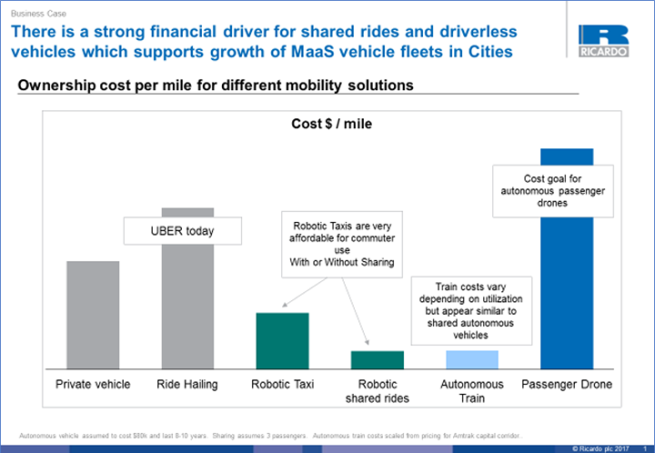
An economic analysis by Ricardo of the transit modes in the autonomous world.
The values shown are the cost per mile per the rider/user. Our two reference values are private car ownership today and our analysis of economics for ride hailing services such as Uber and Lyft for a single occupant. It is interesting that even though ride hailing today is more expensive than car ownership, it is becoming increasingly popular means of transport. The key drivers for its growth include convenience of ordering rides, online payment system and cost savings compared to traditional taxi services to name just three.
To perform the economic analysis for robotic taxis, we assumed these would be designed specifically for the transportation service. These will be highly utilized vehicles operating 20 hours a day (4 hours for charging/maintenance/cleaning). The vehicles are expected to do 250 miles / day equating to 90,000 miles per year. Our expectation is these vehicles will be electric with a range of over 300 miles requiring one charging event per day (during the 4 hour down time) and have powertrains which can last 8-10 years. We also think the interiors will be made to take the wear and tear of use like buses and trains. The vehicles will have additional content to today including significant sensor suites, software and data processing capabilities along with having enhanced connectivity and infotainment systems. For these reasons we expect the purchase price for robotic taxis could be 3 – 4 times the price of the current personal cars, although the costs for sensors, processors and IT systems are dropping rapidly.
Even with the significant increase in vehicle purchase costs, the economics for robotic taxis is significantly better than personal car ownership. This is without factoring in the ever increasing parking costs within cities or the inconvenience of hunting for a parking space.
Mobility with ride sharing is where cost benefits become substantial, very affordable and similar to the cost for public transport. It is also desirable from a societal standpoint as it reduces the energy requirements and emissions per person. Ride sharing is already becoming proving popular with both Uber pool and Lyft line offering cost effective transport. Although some concerns exist now about safety and convenience now, as the services start to be used regularly (for example commuting) then it will be work colleagues sharing (not strangers) and facial recognition and connectivity apps may improve safety and help prevent any previously misbehaving people from traveling. It is possible ride sharing will become the standard mass mobility mode in the future.
Train travel can still have its place in the autonomous world, even if the costs per mile are similar to ride sharing. Trains provide affordable mass people movement, quickly through city / slow traffic zones, have an existing infrastructure and also hubs for inter-modal changes (train to bike, or even bike to car). Coupled with the robotic taxis, users can do multi-modal travel from door to train to door, all coordinated and with minimal delays. This can also provide good accessibility for people with disabilities and for those who don’t drive.
Air travel by autonomous passenger drones also seems to be coming in the relatively near future, with major aircraft companies and start-ups bringing products to market. These vertical takeoff and landing vehicles can utilize technology from the non-passenger drone market to create vehicles with multiple redundancies for safety and easier to fly and manoeuvre than traditional helicopters. The passenger drone is too nascent to make detailed estimation of the economics. Cost targets discussed by companies appear to make passenger drone travel around twice personal car ownership per mile. This would make it a premium service for quick and convenient travel and not an exclusive offering for the wealthy. Hence passenger drone travel could well be an active part of the mobility ecosystem based on economics.
The Rise of Autonomous Mobility Services and fall in city personal car sales
The scenario for the fully autonomous world assumes that as robotic taxis become prevalent there will be very good service coverage within city regions, which reduces the need for personal car ownership to the point it could become redundant. Initially 2 or 3 car ownership households will become single car owner households. This could lead to a future where there is limited personal car ownership. If a personal car is needed for a special trip, it can be rented from Zipcar, Hertz or other car rental companies.
This move to mobility apps enabling consumers to manage all travel, and the drop in personal vehicle usage could yield a markedly different valuechain for mobility. This is shown in the Figure below where the highest value is in the apps consumers use to make their trips. Vehicle OEMs fall in terms of value when they supply to mobility companies and fleets. In contrast suppliers of connected-autonomous driving technology rise in significance. There is also a strong interaction with infrastructure providers including cloud based services, cellular/wifi services and a host of custom information systems hosted off-board the vehicle.
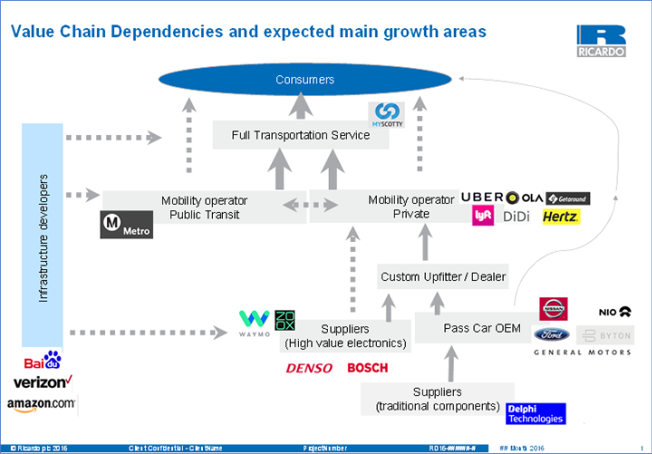
The valuechain shown applies to all future scenarios and shows the increasing importance o software services both on-bard and off-board the vehicle. Note that currently the vehicle OEMs have a high value path to consumers and a lower value path to mobility suppliers. In the fully autonomous work, the vehicle OEM path direct to consumer disappears and leads from a business to consumer (B2C) sales mode today for vehicle OEMs to a business to business sales (B2B) for vehicles to mobility service providers. The B2B sales pathway and valuechain is more akin to the airline or commercial vehicle industries today. This is illustrated in the figure below:
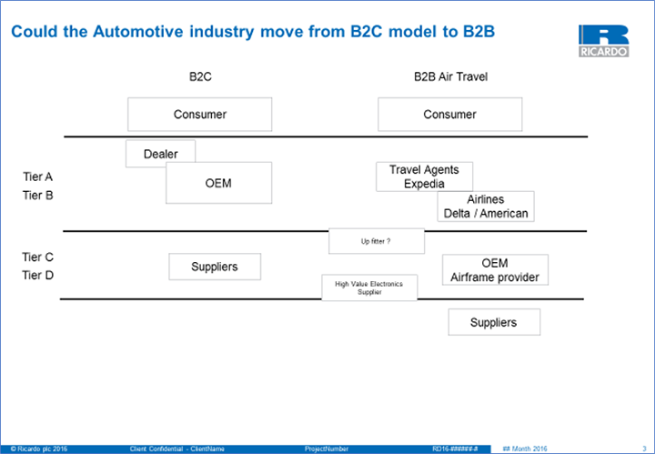
The disruption created by B2B industry model
The B2B model would bring significant disruption to the market place. In the B2B world, the mobility services operators specify exactly which vehicle types and features they want to buy and the number of these. There is limited interest in exterior styling or vehicle OEM brand, since the specifications will likely be about interior features, durability of components and cost. The vehicles may have customized interiors and features as dictated by the mobility service companies, similar to how airlines specify the seating, livery and features of their planes or like the commercial vehicle industry today where fleets specify the equipment they want around standard truck platforms. The RFP to OEMs will create cost competition. The differentiating features will be self-driving comfort, infotainment and interiors and not the styling, performance and driveability features of today. These differentiating features could be quoted separately by preferred suppliers, further reducing the traditional vehicle OEM position in the value chain making the OEMs more of an integrator of other company's systems.
A key concern from the comparison with the airline or commercial vehicle value chain is that in both there are a very limited number of Vehicle / Airframe OEMs globally. Far less than the number of car OEMs today. Our prediction of the reduction of overall vehicle sales is also consistent with a smaller number of OEMs. This is the downside scenario for OEMs, who are already undertaking activities to raise their value and importance in the new mobility ecosystem.
From the commercial and economic perspective, we have described a specific scenario for the autonomous future for mobility in city center areas. This is an ecosystem of fleets of purpose built autonomous vehicles with shared and single occupancy rides, integrated with autonomous trains and passenger drones. This future is underpinned by its affordability and convenience. This can lead to limited demand for personal vehicle sales in cities, and the shared rides and good durability of autonomous vehicles lead to a reduction in total vehicles sales. There is also a marked change in the value chain that includes a potential move to a B2B vehicle sales world similar to airline or commercial vehicle industries. There are a number of winners and losers in the scenario. The winners will be mobility service providers and suppliers with key connectivity, self-driving and infotainment technology. Losers could be traditional vehicle OEMs who lose their value proposition and face reduced volumes, B2B sales and stiff cost competition. Suppliers of mechanical or even electrical/electronic systems will also face increase competition and lower value for their products unless that have strong IP in connectivity or self driving.
The new mobility future with autonomous travel is exciting for travellers but has serious implications for today’s automotive industry if the airline business model materializes. As mentioned, this is just a scenario for the future, of which there are many. However, our takeaway is that the automotive value chain is changing and it is important for companies to invest now to understand how they can future proof themselves against all scenarios and how they can continue to position themselves strongly in the value chain as and when it changes.
Transportation-as-a-Service (TaaS) Technology Conference is a two-day global conference and exhibition dedicated to covering the key topics of the Connected & Autonomous Vehicles (CAV) and Future Mobility industry and it will take place on July 9th and 10th 2018, The Slate, Coventry, UK. The TaaS Technology Conference will bring together international experts for two days of in-depth discussions and exhibits focused on the opportunities and challenges of a mobility future that leverages CAV and TaaS technologies.
Attendees to the conference will hear industry-leading insiders delivering more than 40 presentations spanning eleven key topics. The conference will equip the delegates with an up-to-date overview of the status of the CAV and TaaS industry, and provide them with many opportunities to meet other key players within this community.
The event is being organised in partnership with Coventry City Council, Coventry University and WMG, at the University of Warwick and has attracted an array of leading international experts.
Speakers include: Autosar, AXA Insurance, ARUP, Coventry University, European Investment Bank, Ford Motor Company, HMI Technologies, IBM, IHS Markit, In Motion, Jaguar Land Rover, Local Motors, KPMG, MaaS Global, MaaS Alliance, Microsoft, Nokia, NVIDIA, Orange, Pinsent Masons, Ridecell, SAP, SBD Automotive, SAP, TRL, Thales, TomTom, UBER and Vision Mobility.
With only a maximum of 250 delegate places and 20 exhibitors, the conference is almost sold out. With less than 4 weeks to book your place, less than 30 delegate spaces left and only 2 slots in the exhibition - book today to make sure you are at the must-attend CAV and Future Mobility conference of 2018!
Mobility as a Service (MaaS) is seen as one of the Next Big Things in transportation, allowing people to seamlessly plan and pay for door-to-door multi-modal journeys.
Devrim Kara, Director UK & Ireland at PTV Group and Michael Oliver, Solution Director PTV Visum at PTV Group share their thoughts with TaaS Technology Magazine.
The well-publicised Lisbon Study predicted how the introduction of a fleet of shared vehicles into the city would affect traffic. It discovered that by replacing all car and bus journeys with ride-sharing in small three-person vehicles or taxi-buses of up to 16 people, only five per cent of vehicles would be needed to deliver the same number of trips and that vehicle kilometres and emissions would be reduced. The case for mobility services as an alternative to private ownership is strong, which is why so many different pilot projects are now taking place.
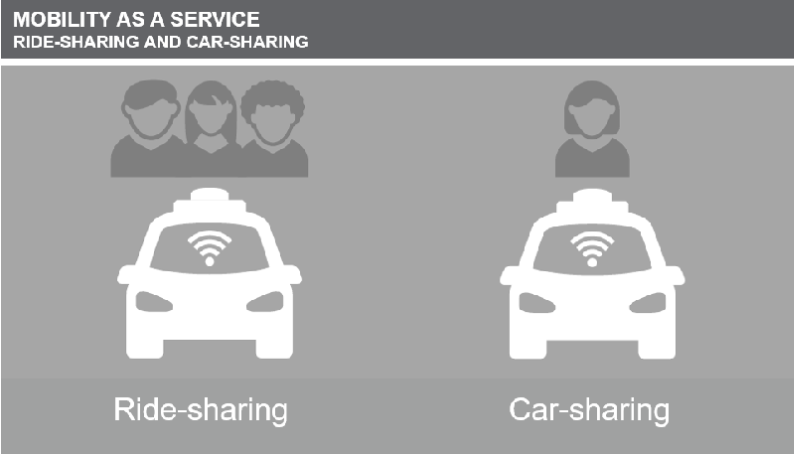
But understanding how a MaaS implementation which integrates services such as ride-sharing will affect a transport network is vital because the wrong assumptions and decisions can easily have negative consequences. For example, in its first iteration the Lisbon Study tested what would happen if all cars were removed from the city and replaced with shared mobility vehicles. The study found that while the number of total vehicles could fall by up to 90 per cent, this would lead to a significant increase in vehicle kilometres. Similarly, reports from cities around the world where ride hailing services have become widespread suggest that these have actually increased the overall number of vehicle kilometres driven.
The MaaS concept is interesting for fleet operators, cities and passengers.
Both fleet operators and city planners want to identify the optimal way to integrate old and new mobility concepts, the optimal number of vehicles that should be deployed, what type of fuel they should use and how many kilometres they will travel. They need to understand how they will facilitate the demand for travel, how much detouring will occur from ride-sharing and demand-responsive transit and how long people would be prepared to wait or detour. Operators must identify how much it would cost to operate the system and how should they price it to be able to make a profit while city planners are interested in increasing accessibility, improving equity, reducing travel kilometres, emissions and congestion.
City planners also want a better understanding of how MaaS solutions can be designed and operated, and to have a say in the design of services deployed in their cities. City managers must ensure new services do not compete with high capacity public transport, but instead give a viable alternative to travel by private car. The city’s objective is to integrate a new service within the finance and resource limitations of the authority for people from all levels of society.
The passengers want the safest, quickest, most comfortable and affordable MaaS service. If they can find a good combination of all these objectives they will switch from their current mode to MaaS or will undertake additional trips or could even reduce the total trips they undertake via better accessibility and efficiency that could be potentially introduced by MaaS services.
This is not a new challenge but made much more complex when dealing with ride-sharing and MaaS, and more important given the potential disruption.
PTV Group, which plans and optimises the movement of people and goods, has therefore developed an off-the-shelf commercially-available tool that can help analyse these concepts and the benefits they can create. The tool works in conjunction with a strategic modelling approach using the well-known widely-used tool PTV Visum. The result is the new PTV MaaS Modeller software to plan and optimise ride-sharing, which, in conjunction with PTV Visum can simulate MaaS journeys and vehicle fleets in a city and beyond.
A strategic transport model can be thought of as a digital replica of the transport system and the socio-demography and economy it serves. A city or a region is divided in to geographical zones which includes the generators and attractors for travel demand such as households, schools, jobs, shops and services. Applying behavioural models to this data results in origin / destination demand for journeys, for example home to work etc. between these zones which can be visualised for example using desire lines. This demand to travel is then mapped to the road and public transport networks using so-called ‘assignment’; consisting of scientifically proven routing algorithms.
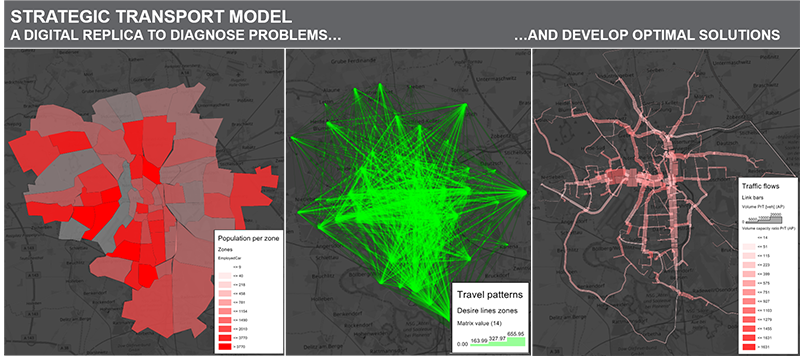
Such strategic transport models traditionally get used to assess the impact of future demand on our transport network against the existing or planned future capacity. PTV Visum has been used around the world for strategic transport modelling for many years, and in conjunction with the PTV MaaS Modeller it is very useful for looking at the opportunities afforded by MaaS.
PTV MaaS Modeller has been developed for use via a web interface and is used to design a ride-sharing fleet taking into consideration an existing network and how it is structured:
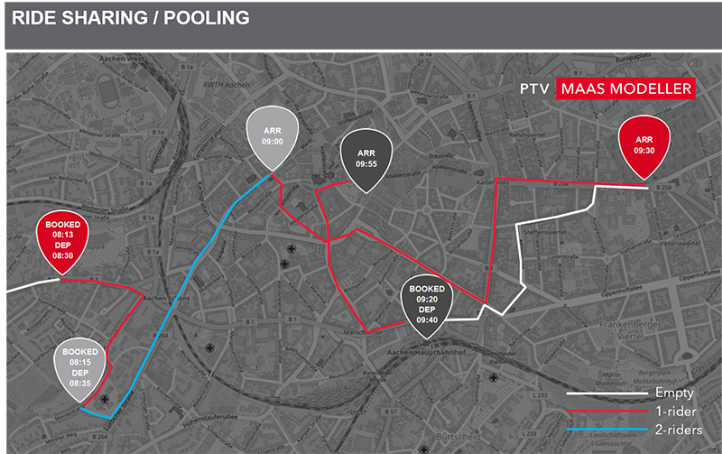
The model’s output details the total driving time to optimise driver allocations (or in the future the impacts of autonomous driving), identifies the number of vehicles needed and the vehicles’ passenger capacity to be able to serve a certain demand and how many vehicle kilometres will be travelled (which is then used to convert into operating costs). It identifies the most effective waiting times that should be guaranteed to users, which allows passenger choices - eg a larger vehicle with more people arrives in ten minutes but a smaller vehicle might only be guaranteed within 20 minutes). Using MaaS Modeller, it is possible to design a MaaS solution that delivers for all - a fast service for those who can pay for it, or a more cost-effective service for those who can wait for it.
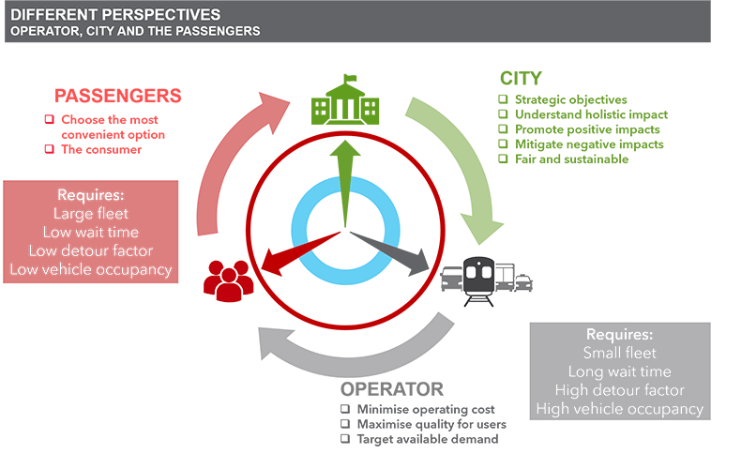
The tool is based in the Cloud and provides the opportunity for the designer of the service to input the many scenarios back into the planning tool PTV Visum to interrogate the exact movement of every single vehicle in a fleet. So in effect the MaaS service becomes a mode in itself within the model, alongside other journey choices. This allows to analyse mode share and mode shift in the strategic transport model which in turn is seamlessly fed back into the MaaS Modeller to identify MaaS waiting time guarantees, detour factors, fleet configurations etc.
PTV MaaS Modeller can be used to design MaaS solutions as part of the entire transportation infrastructure, its mode splits and mode share and trip chains etc. MaaS, as part of shared mobility, truly has a future, and automotive manufacturers and cities agree it is a great way to make the most out of existing transport capacity. However, it is essential that for this to work most effectively, the planning work must be proactive and not reactive – it will be harder to get it right if planning is done only after these disruptive services have been deployed. PTV’s MaaS Modeller is here now to do that proactive planning before it is too late.
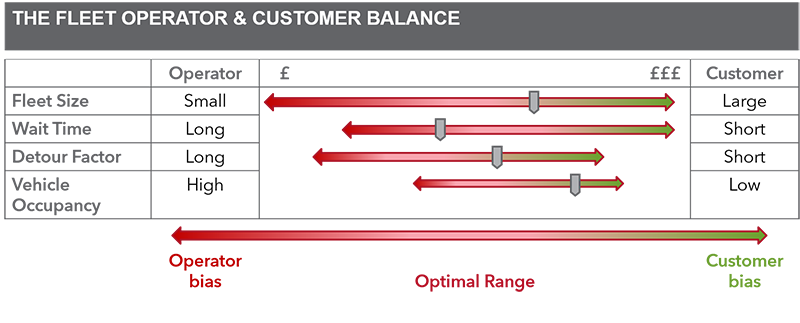
For further information please visit our website www.ptvgroup.com or contact: Devrim Kara, Director UK & Ireland – devrim.kara@ptvgroup.com
Transportation-as-a-Service (TaaS) Technology Conference is a two-day global conference and exhibition dedicated to covering the key topics of the Connected & Autonomous Vehicles (CAV) and Future Mobility industry and it will take place on July 9th and 10th 2018, The Slate, Coventry, UK. The TaaS Technology Conference will bring together international experts for two days of in-depth discussions and exhibits focused on the opportunities and challenges of a mobility future that leverages CAV and TaaS technologies.
Attendees to the conference will hear industry-leading insiders delivering more than 40 presentations spanning eleven key topics. The conference will equip the delegates with an up-to-date overview of the status of the CAV and TaaS industry, and provide them with many opportunities to meet other key players within this community.
The event is being organised in partnership with Coventry City Council, Coventry University and WMG, at the University of Warwick and has attracted an array of leading international experts.
Speakers include: Autosar, AXA Insurance, ARUP, Coventry University, European Investment Bank, Ford Motor Company, HMI Technologies, IBM, IHS Markit, In Motion, Jaguar Land Rover, Local Motors, KPMG, MaaS Global, MaaS Alliance, Microsoft, Nokia, NVIDIA, Orange, Pinsent Masons, Ridecell, SAP, SBD Automotive, SAP, TRL, Thales, TomTom, UBER and Vision Mobility.
With only a maximum of 250 delegate places and 20 exhibitors, the conference is almost sold out. With less than 4 weeks to book your place, less than 30 delegate spaces left and only 2 slots in the exhibition - book today to make sure you are at the must-attend CAV and Future Mobility conference of 2018!
“In the future,” said Soichiro Honda, “there will be just a half dozen car companies. And Morgan.”
That’s an incredible statement, from one of the most brilliant minds in human history, because 1) it assumes no level of innovation or profit can save 10 or more of the largest manufacturers in the world from bankruptcy and/or consolidation, and 2) Morgan, the oldest privately held car maker in the world – notorious for its reliability and production delays – will survive despite a total lack of innovation.What possible catalyst could precipitate this schizophrenic apocalypse?
Doom, thy name is mobility, and those who fail to understand it are toast.
For all the glorious talk about mobility, there’s been very little talk about what it actually is and what it means for auto makers. My inbox is swamped with manufacturer press releases for Smart Mobility, New Mobility, Intelligent Mobility, Yadda Mobility Blahblah, but no one – least of all those media-trained Chief Digital Officers – can explain it beyond buzzwords. Sometimes, over drinks at an overrated lounge in Palo Alto, Detroit, or Austin or (insert German city here), one of them will confess it’s all for show, that “vision” and “innovation” belong to Elon Musk, and that everyone’s waiting for Tesla to implode so the old guard can step in with the manufacturing expertise and management lacking in Fremont.
If your business plan is to wait for Tesla to close doors, I’ve got bad news. Tesla’s survival has no bearing on anyone else’s, because Tesla is no better positioned to survive “mobility” than any other car maker. Therein lies the irony. As soon as car makers start talking about the future, the default enemy is Tesla – who have nothing to do with mobility – followed by a soup of transportation problems that “mobility” will solve.
New mobility: Whoever owns the customer wins
So what is mobility? Is it a goal? A strategy? A product? Mobility isn’t new. If you have two legs, you possess mobility. If you cannot walk, mobility via wheelchair has existed for over 500 years. From the wheel to wheelchair, unicycles, bicycles, trikes, ships, trains, cars, trucks, blimps, planes, rockets, ekranoplans, jet skis, helicopters and the space shuttle, mobility has been defined by the amplification of human will by machine.
So, what is the New Mobility everyone is talking about? The transportation continuum – or the range of options available for getting from A to B – is full, at least until antigravity and teleportation arrive. Only issues of efficiency and friction remain. The New Mobility is therefore the elimination of inefficiencies and friction on the transportation continuum, both within and in between verticals.

Only time will tell which car makers have New Mobility figured out. (Photo: Lyft)
What therefore is the goal of New Mobility? The Multi-Pass from The Fifth Element. Seamless transitions between modes. A single point of payment for anything on the continuum. As Reilly Brennan says, whomever owns the customer wins.
What is the strategy? Glue together as many adjacencies on the continuum. The best example? The evolution of Orbitz and Expedia, from the early flight matrices to travel package bundling. There’s a reason Uber put ex-Expedia boss Dara Khosrowshahi in the big chair.
What is the product? The platform.
Here’s where the unpleasant truth of new mobility kicks in for car makers.
The end of car makers as we know them?
In the New Mobility game, you start out as either manufacturer or a platform. Legacy manufacturers are highly specialized. Car manufacturers make cars. Bike makers make bikes. Aircraft makers make planes. They may dabble in adjacencies, but none are dominant outside their primary verticals. They rarely have direct relationships with end users even within their specialization, which is why in-house/single-brand platforms don’t scale.
What about platforms like Uber, Lyft and Didi? They make nothing, can enter any vertical they choose, and have direct relationships with consumers from Day 1. They can scale like crazy, but require at least one manufacturer in every vertical, in every market, in order to enter them. If Uber needs to own/finance cars, they’re dead.
Does this mean car makers are doomed? Of course not. Regardless of who owns the cars that go onto the platforms, someone has to make them. But as new and more efficient forms of transportation rise (electric bikes/scooters) and new behaviors proliferate (hailing/sharing/pooling), car makers are already under attack from products and services outside their verticals and competencies, against which they perceive no defense except duplication.
If building platforms in-house is madness, investing in external platforms is a strategy, but not necessarily a solution. Margins in car manufacturing are already under terrible pressure. What are the margins for platforms? Terrible, with no end in sight, and no guarantee of improvement even with increasing automation/autonomy. Platform pricing power requires a monopoly. Good luck with that. There’s a reason BMW and Daimler have already merged their mobility units.
But there’s a bigger problem; even if a car maker has a 100% success rate investing in external platforms, adjacent transportation modes, and gluing them all together to fill out the continuum, the end goal of New Mobility – the elimination of inefficiencies and friction in transportation – must destroy car makers as we know them.
Why?
Because self-driving technology forces car makers to choose what their brands actually mean.
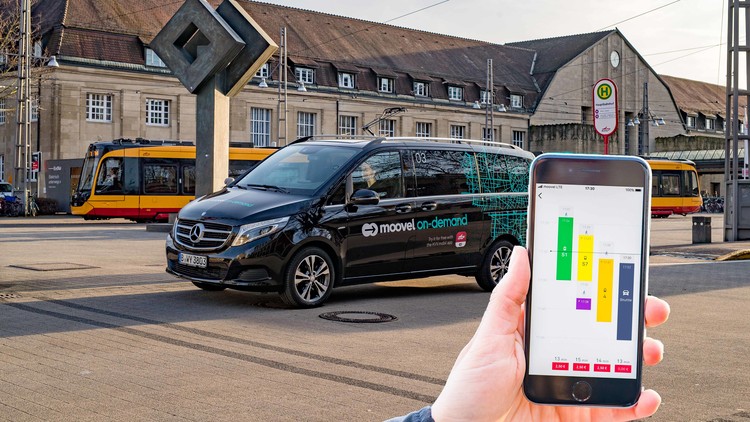
Daimler and BMW recently merged their mobility services. (Photo: Daimler)
It’s transportation vs. transformation
There are two types of car brands: transportation and transformational, which line up perfectly with needs and wants. If everyone bought cars solely for transportation, the Toyota Prius and its equivalents would be the only cars people buy, and Ferrari would be out of business. That transformational brands exist at all is a function of human nature, which is directly coupled to notions of agency, control and status. It’s why racing teams fall under marketing budgets. It’s why people buy Porsches, which as transportation are no better than a Honda Accord.
Amazingly, transformational brands have thrived despite the practical irrelevance of that which defines them. How? By mirroring transportation brand line-ups in a brand-diluting race to the bottom, applying transformational marketing and badging to commoditized transport, and charging a premium.
Which brings us to the dangerous intersection of New Mobility and self-driving.
As New Mobility inexorably moves toward its end state by gluing transportation modes together with increasing efficiency, feelings of agency, control and status are decoupled from brand/car and shift to breadth and depth of modal choice, the majority of it outside traditional 4-wheeled, privately owned vehicles.
Once you remove steering wheels, transportation brands have it easier than their opposites. Transformational brands will have to resolve the conflict inherent to marketing a broadening range of mobility products decoupled from their core brand appeal against a decreasing volume of human-controlled halo vehicles.

Will Morgan Motors survive the New Mobility revolution? (Photo: Morgan)
The surviving six – and Morgan
Transportation brands will fight solely on price, Transformational brands on how well they protect their ability not to have to. How? New Mobility must destroy Transformational car makers as we know them, but only as we know them. The only way to be one of Soichiro Honda’s surviving six is to act decisively while they still can. Several high-ranking German executives have stated that the onset of mobility/autonomy will merely shift their brands – inextricably linked in our culture to sex, power and speed – from human-controlled performance to autonomous luxury. This is madness, no better than sprucing up a houseboat while throwing out the engine.
Dieter Zetsche may reject the idea of Daimler becoming the Foxconn to external platforms, but that only works if he is willing to sacrifice one of his own brands to New Mobility while preserving the others: Mercedes-Benz must become the commoditized transportation brand cutting horizontally across all platforms, Maybach the halo brand for strictly limited services across some platforms, and AMG the brand exclusively reserved on one platform for vehicles that retain steering wheels (albeit with autonomy as a standard option).
If you’re going to create sub brands, the strategy and messaging must be laser focused.
When Soichiro Honda said there would only be six car makers left...and Morgan, he was right. Maybe not about the six. It might be five, or seven. But that Morgan part was spot on. If the makers of unreliable, wooden-framed, lightweight, fun-to-drive, uncomfortable yet hyper exciting sports cars can survive in the era of Miatas and Boxsters, there will always be a place for brands selling emotion, agency and freedom, real – or, in the age of autonomy, perceived.
And that's why I own one.

This article was produced by 2025 AD, the original artical can be found at: www.2025ad.com
About the author:
Alex Roy – an angel investor, entrepreneur, Editor-at-Large for The Drive, Host of The Autonocast, co-host of /DRIVE on NBC Sports, author of The Driver and Founder of Noho Sound – has set numerous endurance driving records in Europe & the USA in the internal combustion, EV, 3-wheeler & Semi-Autonomous Classes, including the infamous Cannonball Run record. You can follow him on Facebook, Twitter and Instagram.
By Marc Jadoul, Marketing Director at Nokia
A famous quote, attributed to (but probably never said by) Henry Ford, is: “If I had asked people what they wanted, they would have said faster horses.” Well, the Tin Lizzy did not look like a horse at all, and still it was named the most influential car of the 20th century. If we look at some of the mainstream innovations that happened in automotives since the commercialization of the Ford Model T in 1908, they are not about speed. Take, for example, the electric starter (1911), the cigarette lighter (1925), the car radio (1930), power steering (1956), ABS (1978), airbags (1984), GPS (1995), or more recently the introduction of Bluetooth technology and parking sensors in cars.
True innovation is created by visionaries, who think beyond current products and succeed in fulfilling the (sometimes small) unformulated or unmet needs of their customers. As such, innovation is about creating new user experiences or changing the value proposition of existing products and services. And, the American car pioneer was right: for most of today’s car owners, design, driving comfort, and user experience are far more important buying criteria than speed. Many road safety organizations are even calling for performance figures to be banned in car advertising and sales collateral.
Connectivity will further fuel vehicle innovation
Adding Vehicle-to-Everything (V2X) connectivity to the timeline with innovations does not change the challenge that Ford formulated: how can we make a ‘connected car’ more than an ‘autonomous horse’? And what will be the impact of new information and communication technologies like 5G wireless networks, software platforms, and the Internet of Things on road safety, business models and the user experience of drivers and passengers?
Gartner predicts that by 2020, about one in five vehicles on the road will have some form of wireless network connection, evolving from satellite, 3G cellular, and LTE to 5G wireless. 5G will become the unifying technology for V2X communication, providing high capacity, low latency, and strong security to support extremely diverse applications for drivers, passengers, and car manufacturers and service providers.
New business models built upon sensors, software, and services
McKinsey & Company defines a connected car as “a vehicle able to optimize its own operation and maintenance as well as the convenience and comfort of passengers using onboard sensors and Internet connectivity.” These technologies will have an immense impact on road safety, business models, and – most of all – the user experience. Enabling new applications like predictive maintenance, fleet management, and driver monitoring.
You may be asking yourself what this could mean for Henry Ford’s legacy. Well, Don Butler, executive director of today’s Ford Motor Company, thinks that in the near future roughly 50% of a car’s value will be in hardware and the other 50% will be divided between software and experiences and out of vehicle content. With sales growth slowing down due to the rise of new mobility services such as car sharing and e-hailing, the automotive industry will have to reinvent itself – from a hardware focus to a software focus, from application thinking to platform thinking, and from vehicle selling to services selling.
If you want to get an idea of a use case for a connected, IoT and software-enabled vehicle, then take a look at this video of the connected rental car that was developed by IoT Community members: Hertz, Continental, SAP and Nokia. The project was built on the assumption that assisted or autonomous driving, and pervasive connectivity was a given; and opens up a plethora of business models taking advantage of those enablers.
The era of driverless cars is coming quickly into view, and most major automotive manufacturers have announced plans for various levels of vehicle autonomy in 2020-2021. American think tank RethinkX even predicts that by 2030, 95% of US car miles will be travelled in self-driving, electric, shared vehicles.
Four wheels, 5G, and a whole new user experience ahead!
When cars go driverless, connectivity, sensors, software, and services will take over the driver’s seat. The connected car of the future will come with 4 wheels, 5G, and a whole new user experience for drivers, passengers, and pedestrians. Because we all want our next car to be more than a faster and smarter horse, don’t we?
If you’re keen to hear more in person, I’ll be presenting on the future of connected cars at the TaaS Technology Conference in Coventry in June. Nokia also demonstrated the next version of its connected car (which is a Ford Mustang, by the way) at the Mobile World Congress in Barcelona – yes, the guy on the photo is me.
(This article was originally published on the Nokia Blog on 22 January 2018)
Transportation-as-a-Service (TaaS) Technology Conference is a two-day global conference and exhibition dedicated to covering the key topics of the Connected & Autonomous Vehicles (CAV) and Future Mobility industry and it will take place on July 9th and 10th 2018, The Slate, Coventry, UK. The TaaS Technology Conference will bring together international experts for two days of in-depth discussions and exhibits focused on the opportunities and challenges of a mobility future that leverages CAV and TaaS technologies.
Attendees to the conference will hear industry-leading insiders delivering more than 40 presentations spanning eleven key topics. The conference will equip the delegates with an up-to-date overview of the status of the CAV and TaaS industry, and provide them with many opportunities to meet other key players within this community.
The event is being organised in partnership with Coventry City Council, Coventry University and WMG, at the University of Warwick and has attracted an array of leading international experts.
Speakers include: Autosar, AXA Insurance, ARUP, Coventry University, European Investment Bank, Ford Motor Company, HMI Technologies, IBM, IHS Markit, In Motion, Jaguar Land Rover, Local Motors, KPMG, MaaS Global, MaaS Alliance, Microsoft, Nokia, NVIDIA, Orange, Pinsent Masons, Ridecell, SAP, SBD Automotive, SAP, TRL, Thales, TomTom, UBER and Vision Mobility.
With only a maximum of 250 delegate places and 20 exhibitors, the conference is almost sold out. With less than 4 weeks to book your place, less than 30 delegate spaces left and only 2 slots in the exhibition - book today to make sure you are at the must-attend CAV and Future Mobility conference of 2018!
So says a new Paper, in so many words, which was published on the 6th June 2018 by Transport Systems Catapult (TSC) and the University of Sheffield about Blockchain's potential uses in transport. The Paper injects a much-needed note of authority and realism into the froth surrounding this topic.
The power of the internet to spread the word about new inventions means that the world is already awash with soothsayers predicting Blockchain's power to transform many industries. Therefore, TSC's report has arrived not a moment too soon for the transport sector.
Using its own highly skilled resources and calling on a wide range of experienced academics, including Prof. Lenny Koh from Sheffield University, TSC's Paper injects some much-needed realism and explanations about what Blockchain could do for transport, with several summarised use-cases, some pointers to how we should set about it and a useful assessment of some of the risks.
It is the the "how" and the "risks" that I am focused on because, whilst the internet is great at spreading ideas and enabling peer reviews of inventions, as well as providing the infrastructure for digital technology to run on, it also tends to increase expectations long before the hard work has been done to make new digital inventions a reality. Imagine if James Watt's proposed improvement of Newcomen's steam engine had been subjected to this amount of public scrutiny before he had even built a working prototype. This could well have led to people in periwigs and frock coats to imagine themselves flying around in the baskets of steam-powered balloons. So, I apologise for seeking to bring us all back down to earth, but I want to build on TSC's call for proper investigation and funding for the potential uses of Blockchain and urge that we find some money, as soon as possible, to actually build some stuff. I know this is starting to happen but we need more of the same, a lot more.
Blockchain brings with it significant risks. It may not turn out to be good at everything or even good at some of the use cases that TSC has proposed. The technology is in its infancy. The allure of decentralisation and the level of protection it affords through immutability sound great. However, some Blockchain implementations do not run very quickly, make inefficient use of compute resources and storage and introduce unacceptable latency. Bitcoin, the most famous implementation of the technology so far, has certainly found that out. Part of the reason for that is the global "mining" activity involved in Bitcoin transactions but we should not forget that transport is every bit as global an activity as financial services, so we need to think very carefully about how to architect its roll out across the sector to avoid issues of latency and excessive consumption of compute resources.
If ever there was a case where it is not enough for a small prototype to demonstrate that something can be done, Blockchain is it. I have been pulled in to troubleshoot too many projects where not enough load, stress and soak testing was done and where no-one thought sufficiently about the large scale production architecture, to be caught out by that one. It is not enough for the thing to do something cool in a lab environment, it has to be repeatable all over the world, with a throughput of tens of millions of transactions every day, before I will call it "cool". I have some confidence that these challenges may be solved, and some already are being, but we must be prudent and not expect too much too soon.
I have been a technologist for more than thirty years and, amongst some of the harder lessons I have learned, one that stands out is what Mike Bracken @MTBracken, the first Director of the Government Digital Service, has so succinctly described as "do the thing".
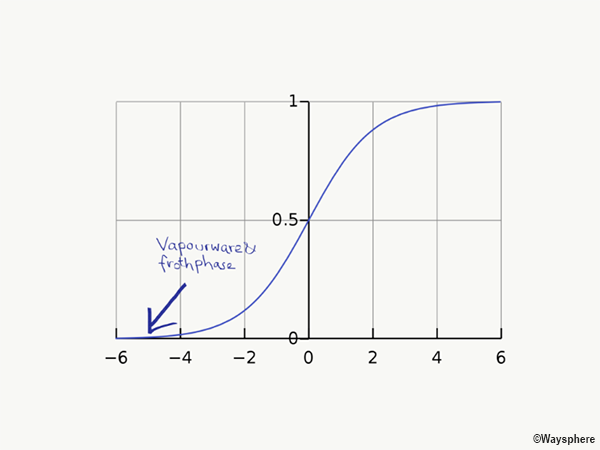
In the S-Curve of adoption we are very much in the vapourware & froth phase of Blockchain's application to the transport sector. What we need to do is get on and build some stuff as quickly as possible. At present the only big thing I know of that is exploring how to scale is IBM's work with Maersk using Hyperledger. There may be others. All I am saying is that I haven't found any that are terribly convincing yet.
Blockchain is very much a technology where we will learn by doing. Colleagues I work with regularly @Valtech including Dan Klein @DPLKlein have learnt a lot by actually building an automotive Blockchain. Dan told me that one of the most important lessons the team learnt on that project, which applies to a lot of technology projects, is that if you have clever people doing the tech they can do a lot of stuff quickly and exquisitely but it is defining the human interactions and meeting user needs to get the service right that you need to focus on, as Valtech rightly did. Getting those wrong will slow you way down if you don't do proper user research. You need to understand user needs and test and learn iteratively in a disciplined way using an Agile Delivery methodology, dividing work up into sprints and taking a proper approach to developing a series of minimum viable products (MVPs). Blockchain is currently in the "unknown problem space" as my friend Simon Wardley @swardley would say, in relation to his approach to value-chain mapping. Therefore its many potential use cases are ideally suited to being developed using Agile Methodology.
Transportation-as-a-Service (TaaS) Technology Conference is a two-day global conference and exhibition dedicated to covering the key topics of the Connected & Autonomous Vehicles (CAV) and Future Mobility industry and it will take place on July 9th and 10th 2018, The Slate, Coventry, UK. The TaaS Technology Conference will bring together international experts for two days of in-depth discussions and exhibits focused on the opportunities and challenges of a mobility future that leverages CAV and TaaS technologies.
Attendees to the conference will hear industry-leading insiders delivering more than 40 presentations spanning eleven key topics. The conference will equip the delegates with an up-to-date overview of the status of the CAV and TaaS industry, and provide them with many opportunities to meet other key players within this community.
The event is being organised in partnership with Coventry City Council, Coventry University and WMG, at the University of Warwick and has attracted an array of leading international experts.
Speakers include: Autosar, AXA Insurance, ARUP, Coventry University, European Investment Bank, Ford Motor Company, HMI Technologies, IBM, IHS Markit, In Motion, Jaguar Land Rover, Local Motors, KPMG, MaaS Global, MaaS Alliance, Microsoft, Nokia, NVIDIA, Orange, Pinsent Masons, Ridecell, SAP, SBD Automotive, SAP, TRL, Thales, TomTom, UBER and Vision Mobility.
With only a maximum of 250 delegate places and 20 exhibitors, the conference is almost sold out. With less than 4 weeks to book your place, less than 30 delegate spaces left and only 2 slots in the exhibition - book today to make sure you are at the must-attend CAV and Future Mobility conference of 2018!
Even though around 1.2 million lives are lost in traffic accidents around the world each year – and more than 90% of collisions are caused by human error – polls show that people are still more comfortable having humans in control of cars instead of machines. And this is with the acceptance of driver assistance systems growing among new vehicle buyers, familiarizing them with the concept of the car taking over certain driving tasks, such as automatic emergency braking.
But trepidation about new technology is common, and self-driving tech is the latest victim in a long history of anxiety among consumers when it comes to groundbreaking innovation. An article in The Atlantic from 2015 titled “When People Feared Computers” quaintly recalls how the public was troubled by the proliferation of PCs three decades ago, echoing concerns about smartphone use today.
The article also notes that “humans often converge around massive technological shifts with a flurry of anxieties,” which perfectly describes the public’s current resistance to self-driving cars. One method that has helped people become more accepting of new advances is the anthropomorphizing of technology – assigning human characteristics to non-human entities, such as self-driving tech.
Building a driver
Since the beginning of civilization people have anthropomorphized mountains, rivers, animals and other aspects of their natural environment. With technology, this process has taken the form of everything from people naming their cars to Apple giving its voice assistant Siri a sassy sense of humor.
That’s why it caught my attention when Waymo CEO John Krafcik recently made a point of saying that the self-driving division of Alphabet Inc. is developing a driver as opposed to autonomous technology. “At Waymo, our goal is to build self-driving vehicles for every trip for every purpose,” Krafcik said at a press conference I attended during the New York Auto Show, and where Waymo announced a new partnership with Jaguar. “We can do this because we’re building the driver and this same driver can be adapted for all kinds of vehicles,” he added.
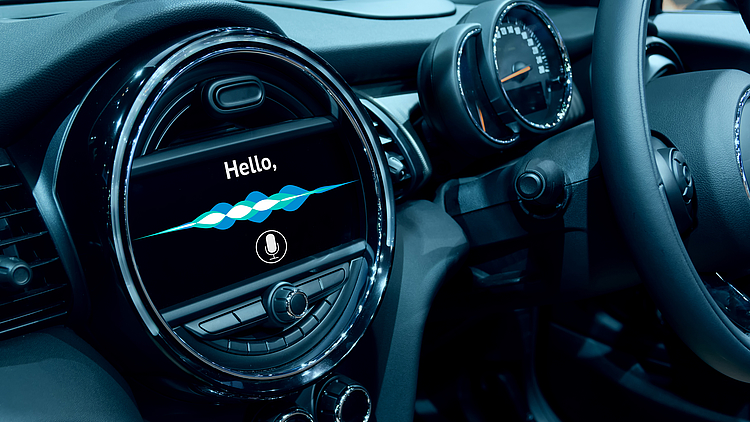
Anthropomorphizing technology: Is it just human nature? (Photo: Adobe Stock)
Technically speaking, this is not an entirely new concept for Waymo. In early 2016, Google succeeded in having the National Highway Transportation Safety Administration consider its self-driving technology a “driver” under federal law. In a Recode article from the same year Waymo’s CTO and VP of engineering Dmitri Dolgov stated that the company’s goal was to develop technology that, like a human, can drive any car. What is new, however, is the extent to which the concept is now being communicated.
“As far as the software is concerned, it’s like getting into another car,” Dolgov said in the article. “You get a rental and maybe it’s a little bit bigger and it doesn’t quite handle the same way as your own car. It takes you time to get used to, but the core tasks transfer,” he added.
Dolgov pointed out that the “driver” that Waymo developed has piloted a Prius, a Lexus SUV, a Chrysler minivan, and the company’s own prototype, and will soon drive a Jaguar I-Pace. Like Krafcik, Dolgov added that Waymo’s objective isn’t to build a car: “We’re building a driver,” he said.
Google builds a cute car
When Waymo did build its own self-driving vehicle, the Firefly prototype, it created what’s been called “the cutest thing” Google ever made. As Waymo wrote in a Medium post, observers have compared the Firefly to a “koala car or gumdrop.” Even though Waymo detailed the practical aspects of Firefly’s design in the Medium post (and has since retired the prototype in favor of using production cars), its charming look probably wasn’t an accident.
Bryan Reimer, a research scientist at the MIT AgeLab and associate director of the New England University Transportation Center at MIT, observes that by building a likeable, non-threatening prototype like Firefly, Google sought to mitigate any perception of risk that self-driving technology may pose to other road users. “It’s a case of making a robot look less aggressive,” he said.
But Reimer believes that if companies want self-driving tech to be trusted by the public, they should create vehicles that look even less like traditional cars. “They should dehumanize it so it looks like something else,” he said.
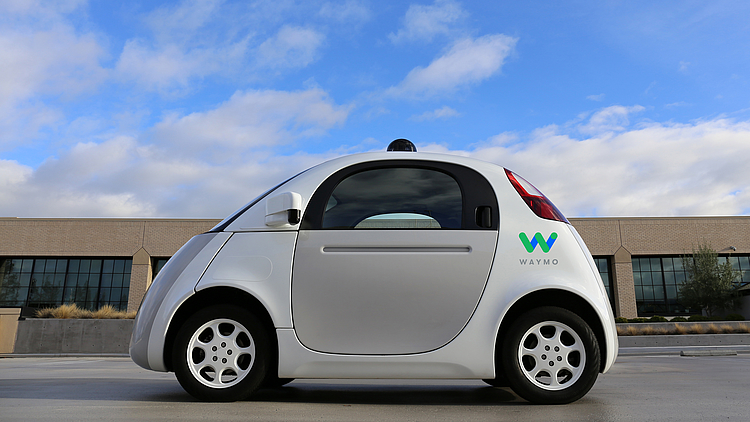
"Awww...isn't it cute..." (Photo: Waymo)
Success by any other name
A similar idea has been applied to creating robots that deliberately don’t look like humans. There’s even a name to describe the delicate balance in designing robots so that they’re appealing and not intimidating to people based on how they look: robotics professor Masahiro Mori coined the term The Uncanny Valley in 1970 to explain how when robots reach a certain level of realism they can cause a negative reaction.
In the same way – and as Reimer suggests – perhaps Waymo and other autonomous tech developers could combat negative perceptions of self-driving cars by taking a more radical approach to vehicle design. Or at least instead of creating sleek concepts like the Mercedes-Benz F 015 Luxury in Motion go for cute cars like Waymo’s Firefly.
Regardless of whether we ultimately label autonomous technology a “driver” or what it looks like in vehicle form, if it can save the millions of lives lost around the world each year in traffic accidents, we can simply call it a success.

This article was produced by 2025 AD, the original artical can be found at: www.2025ad.com
Many start-ups and large technology companies alongside automotive OEMs are engaged in an intense competition with massive research and development budgets and investment led acquisitions and collaborations to get autonomous mobility working.
Zain Khawaja, Founder & CEO, Propelmee shares his thoughts with TaaS Technology Magazine.
There have been multiple demonstrations of autonomous mobility, yet we don’t see anything that is near market or ready for deployment. The road to full autonomy has two key open challenges, which need to be addressed. The first one is robust and failsafe perception and the other is reliance on HD maps. Unless the industry can break through these two major barriers, we are likely to see the hype of expectations disappear into the trough of disillusionment.
The driverless car industry is progressing at a rapid pace, with large automotive manufacturers, software giants, and nimble start-ups all competing to develop new breakthrough technologies to plant their flag on the global playing field and secure a position in the expected multi-trillion dollar market. Many prominent figures within the driverless car industry have often spoken about the benefits which a fully driverless world could bring: reduced congestion and pollution, safer and more efficient roads, mobility for the elderly and young, more productive land usage with fewer parking spaces, and many more. There are a multitude of potential socio-economic benefits that driverless car technology could bring about beyond the wildest expectations and speculations of experts today – imagine predicting the socio-economic impact of the first manned flight by the Wright brothers as a new technology on the development of the global aerospace and aviation industry in the years that followed.
There are four main factors underpinning the hyperactivity in this new technology arena:
These are powerful factors, but as yet, have not been enough to accelerate the onset of driverless cars on roads today. In this race, losing sight of the main goal of invention has seemingly been pushed down the order to quickly capture the market. One of the common outcomes in such situations is that actors become more willing to solve the easy problems. In my view, the state of play in self-driving cars is not a lot different. Many large companies are trying to tackle this challenge simply via resource allocation – more funding, more engineers, and more cars. However, drawing on the past, the Wright brothers didn’t invent the world’s first aeroplane because they had the largest engineering teams or the most money/investment. Surprisingly, one of the greatest innovations in human history came from two brothers who did not have a college degree, funded only by their bicycle repair shop.
There is much the self-driving car industry can learn from the story of the Wright brothers, and the first and most important lesson is to solve the real problem. The Wright brothers realised in contrast to their contemporaries that aircraft control, not propulsion, was the key to manned flight and dedicated their efforts to controlling airplanes. And by solving the right problems, one after another, they took off at Kittyhawk and changed history forever.
The question is that if autonomy is already working across so many demonstrations of technological capability, then where are the promised autonomous cars and when will they get here. In fact, we are in the long tail of technology capability development with the most critical open challenges that need to be solved before market ready solutions can be commercially deployed – in short, we need breakthroughs in two areas related to autonomous capability. In Sacha Arnoud’s words, Director Engineering and Head of Perception at Waymo, “when you’re 90% done, you have 90% to go, in other words you need 10X improvement”.
Today’s autonomy approaches are not scalable and only work in specific pre-mapped geo-fenced areas and only in particular environmental conditions (not too sunny, no rain, day only…etc.).
The open challenges
There are two open technology challenges constraining the capability of autonomous mobility today. One is ‘Perception’ and the other is ‘Three Dimensional (3D)/ High Definition (HD) mapping’. Perception is the conversion of raw data captured by sensors on-board the autonomous vehicles into ‘scene understanding’. As humans when we look, we see the world around us and instantly understand where everything is – meaning even if we don’t know where we are in the world, we can still see where the road or path is, whether it is blocked by something (that we may or may not have seen before), where the road kerbs are, where lane markings are and whether we are at a junction or not. When a sensor acquires input data from the environment (a camera or LIDAR for example), it spews out raw numbers as bits and bytes referencing the depth or pixel values. The major challenge at this stage is how to derive the understanding of the scene from this raw information that can guide the manoeuvres of the vehicle (stop, slow down, accelerate, avoid etc.). Perception is extremely hard and yet, it is the core of the autonomous capability. One can easily imagine the difference in mobility capability of a sighted person compared to someone with visual impairment to negotiate a complex crowded route safely.
Why machine learning alone is not enough
The current approaches to Perception in most, if not all, autonomous technology development programmes rely almost entirely on Deep Convolutional Neural Networks (CNNs). These are Machine Learning frameworks, which allow cars to learn to recognise what things look like (roads, buildings, people…). This approach is riddled with constraints and issues.
The points above clearly explain that neural networks alone do not solve the open challenge of perception.
3D/HD Maps are not navigation maps
3D/HD maps are point-in-time, detailed three dimensional road surveys typically relying on laser data. This survey data is annotated to mark the position of lanes, roads, traffic lights, signs and other important road infrastructure. When an autonomous vehicle drives through the surveyed road, it matches live sensor data to the stored map data to estimate its position relative to the survey. It can then pinpoint the location of road features as stored in the survey – like memorising what the world looks like in 3D. As the environment changes, surveys and annotations need to be updated. 3D/HD maps are costly, sensitive to environmental changes, and do not scale. One hour of mapping input data requires 800 man-hours of annotation effort and 1 mile of driving data requires 2 terabytes of storage. For mapping-based autonomy to scale, 3D/HD maps must be made by manually driving every road on the planet. The road network in the top 50 countries of the world by road network size, totals up to 60 million Km. A finer point about the scale of this task is that this data has to be collected in both driving directions, updated frequently to keep track of changes – petabytes of storage. This is a monumental challenge and all the current approaches will remain constrained to specific ring-fenced pre-mapped locations with limited route capability. There have been some suggestions on crowd sourcing the collection of 3D/HD maps by the autonomous vehicles themselves while they drive on various roads in order to keep the maps updated when the pre-mapped information is no longer accurate or fresh. The reality is that map failures are abrupt and severe (loss of signal to cloud database, sudden change in environment, roadworks, fallen tree…) and updating small changes doesn’t fix this. Only an autonomous car that does not rely on the 3D/HD map can navigate the abrupt change and update the data for other cars blindly following the map. It is ironical because mapping-based autonomy will forever require a fleet of human operated cars to update maps.
Model free Perception
Propelmee has made a break through in the state-of-the-art in Perception by building and testing a ‘model-free’ technology to convert raw sensor data input into scene understanding, which does not require training a network through datasets. Our perception gives autonomous vehicles unparalleled scene understanding in diverse complex environments. Our perception technology is scalable all over the world and detects every obstacle and road, anywhere - unlike anything ever developed before. This capability sits at the core level of our perception technology stack and
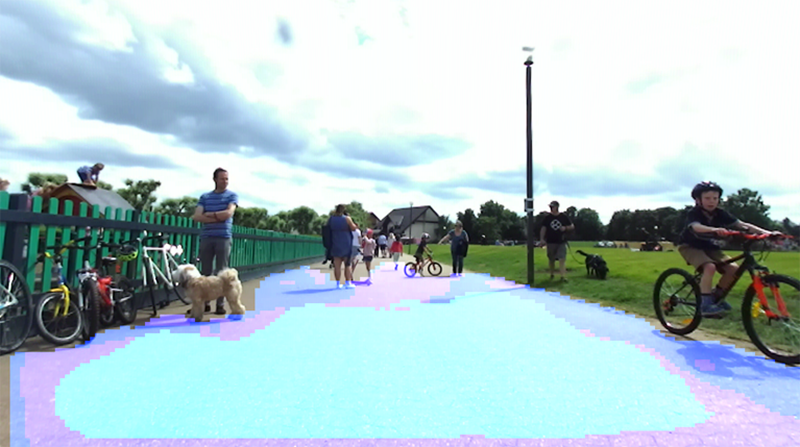
Propelmee – Detection of surfaces
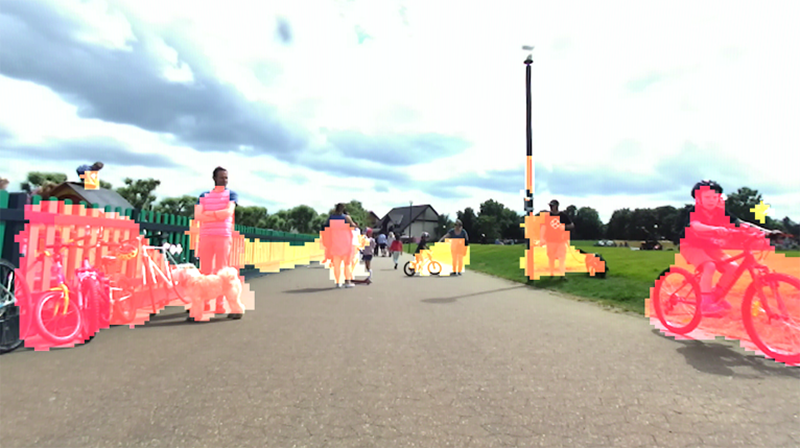
Propelmee – Detection of all types of obstacles
Autonomous vehicles today don’t have this model free perception technology and cannot perceive the world in such rich detail therefore autonomous cars need to rely on 3D/HD mapping to overcome the limitations in their perception.
Autonomy without 3D/HD maps
Propelmee’s ground breaking model-free perception has led to the development of a new technology – ‘Perceptual Localisation’ which enables autonomy without 3D/HD mapping. Perceptual Localisation utilises model-free perception to estimate vehicle position in a 2D navigation map (bird’s-eye view) eliminating the need for manually pre-surveying and pre-mapping the roads manually.
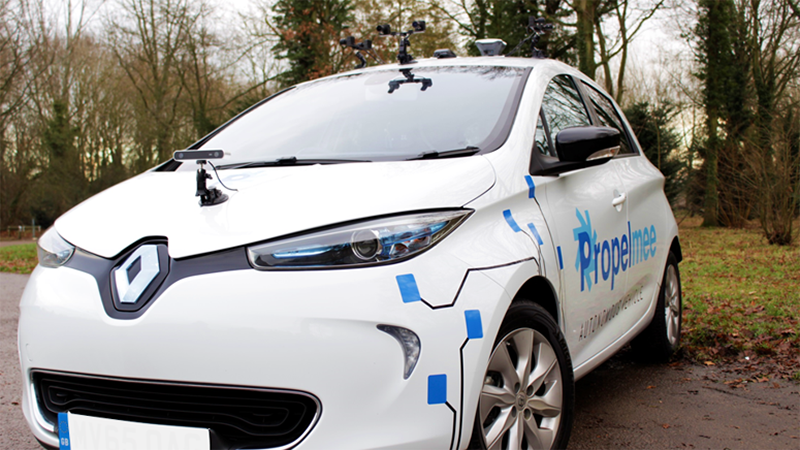
Propelmee – autonomous car platform
Level5 autonomy
The idea of a flexible and hailable, any origin to any destination Mobility-as-a-Service (MaaS) powered by autonomous vehicles needs the autonomy that is operative in any city, region or country without any training or mapping data. The main driver of adoption of autonomous MaaS by current fleet operators is a significantly lower operating cost model for a 24X7 service. Robust and performant Level5 automation (no driver required) is possible only with model-free perception and pre-mapping free capability.

Zain Khawaja – Brief Profile
Zain has completed a 4-year Masters of Engineering (M.Eng) degree from the University of Oxford, where he studied Computer Vision, Robotics, Machine Learning, Control Systems and Advanced Mathematical Methods. His capstone project at Oxford, on ‘Visual Motion Magnification’ of imperceptible motions, was completed under the supervision of Dr. Andrea Vedaldi, and it extended the work performed by MIT researchers in ‘Eulerian Video Magnification’. Zain won the prestigious departmental ‘Sony Award’ for his academic poster presentation. While at St Anne’s College, Oxford, Zain was privileged to be under the direct academic tutorship of Professor David Murray, who set up Oxford University’s ‘Active Vision’ Laboratory.
Zain has worked as a Software Engineer, with Oxbotica as part of their early team, and has hands-on experience of several autonomous car platforms, working on; vehicle sensor integration and configuration, autonomous run data logging, autonomous vehicle computer assembly and install, performing autonomy trials and conducting autonomous vehicle testing. Zain was involved in the logistics management and development of the testing protocols for the first autonomous car trials in Milton Keynes (LUTZ), and he has also worked on the testing and deployment of the first ‘GATEway Pod’ at Greenwich, UK.
As the Founder & CEO of Propelmee, Zain leads the technology development of the company’s entire autonomy stack and is the lead author on three US patent applications relating to the core technology stack.

2025AD: Dr Wisselmann, you can be considered a pioneer of automated driving, having worked on driverless cars since 2004. What was your first encounter with the technology? Why did it fascinate you?
Dirk Wisselmann: One job of a researcher in the automobile industry is to “transform” future mobility visions into hardware so that the vision can be physically experienced as a basis for an internal evaluation. We picked up the topic of autonomous driving – in a BMW specific manner - in the year 2004 driven by a technical fascination. The result was the “BMW-TrackTrainer” – a car that was driving autonomously on the ideal line of racetracks with racing speed. We used this technology on many European racetracks within our driving training.
2025AD: How has the significance of automated driving developed over the years at large car manufacturers like BMW?
Dirk Wisselmann: The increasing automation of vehicle functions is inextricably tied to the development of cars. Therefore the introduction of advanced driver assistance systems (ADAS), like parking distance control (PDC) or the radar based speed and distance control (ACC), in the nineties of the last century was a logic step. The enormous increase of the performance of these ADAS in the last years will now make the next step realizable – to give the driver the possibility to completely delegate the driving task to the car if he wants to do so. Fully automated driving also offers the chance to realize completely new mobility concepts with a high potential to optimize the traffic situation especially in urban areas.
2025AD: Surveys show that many consumers remain skeptical when it comes to driverless cars. How can OEMs tackle this issue?
Wisselmann: If you ask „normal“ drivers, if they want to use a self-driving car, you are very often facing a high degree of skepticism, especially in Germany. The people are scared or irritated by the loss of control, the aspects of safety, the individual benefits and so on. In my experience, these negative arguments disappear once the drivers experience an autonomous car in real life. Then they are fascinated that the cars are already working very well, they develop trust in the new functionality very quickly and they acknowledge the positive aspects of comfort and safety. Therefore, I am sure that we will not have any acceptance problems with autonomous driving. The prerequisite is of course that the autonomous car is driving on a very high technical level. The reverse conclusion is also valid: a “bad” autonomous car confirms all prejudices and worsens the acceptance situation.
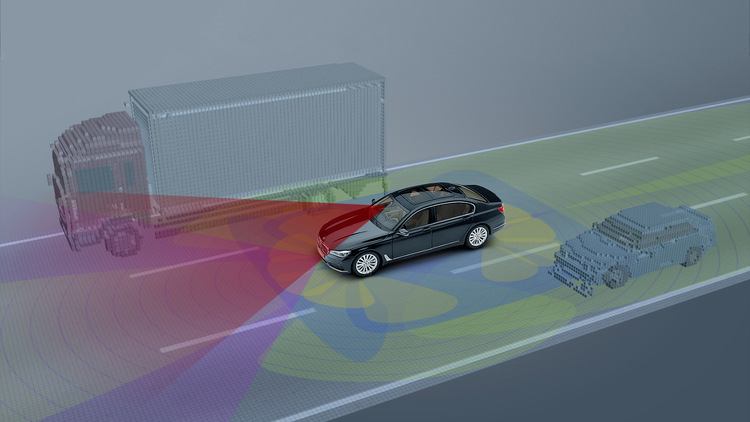
Highly automated driving is a research focus of BMW. (Photo: BMW)
2025AD: Most consumers haven’t seen an autonomous vehicle on the road yet, let alone sat in one themselves. Some of your competitors like Volvo include average consumers in their testing efforts, hoping to increase acceptance. What is BMW’s stance on this?
Wisselmann: The evaluation of new functionalities by normal customers to the earliest possible date is an integral part of the standard development process of BMW. The first evaluation usually starts in the driving simulator. In the next step, BMW invites customers to test drives on test and proving grounds and on public roads at a later stage of the development. All these activities are ongoing in an intensified mode today for the development of our highly and fully autonomous cars. An even broader field operational test would have to be discussed with respect to communication aspects.
2025AD: Once they use them, people tend to quickly trust automated cars, which can create risky situations if they suddenly need to take back control. Did you have similar experience with test drivers? What can be done to avoid this “complacency effect” – or should we skip Level 2 and maybe even 3 straightaway?
Wisselmann: Theoretical discussions of the human-machine-interface of so called level-2 functions, for example the lane and steering control assistant, are very often critical, because these functions take away the “workload” from the driver and they degrade him only to monitor the driving task. In reality, the circumstances are different. A broad investigation of the accident behavior of one million BMW cars equipped with level 1 and 2 functions over the period from 2014 to 2017 has shown that these cars had between 15 and 60 percent less accidents than cars without any ADAS. This enormous increase in safety shows that all theoretical secondary effects like “overtrusting” are by far overcompensated. For this reason, we see the introduction of level 3 functions as an important first step. In specific driving situations the car requests the takeover of the human driver, for instance to drive through a complex working zone. Intense studies in driving simulators have shown that the driver has enough time to execute this takeover process safely. In the medium term, these level 3 functions will be replaced by level 4. Then, the driver will be able to sleep on a long distance trip on highways because the car is able to handle safely all driving situations by itself.
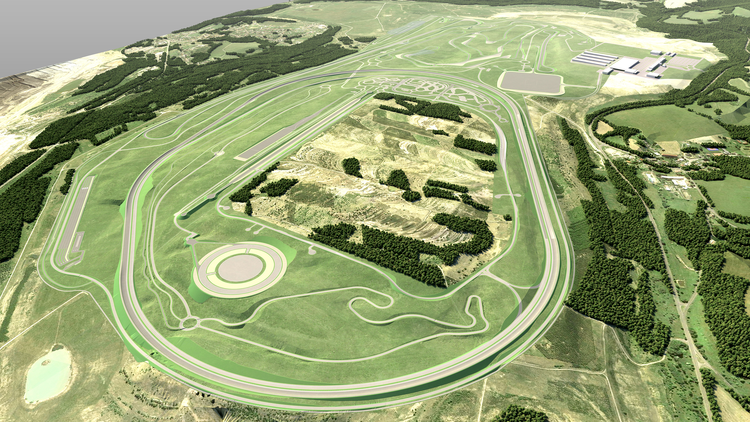
Aerial view of BMW's testing track in Sokolov, Czech Republic. (Photo: BMW)
2025AD: We all hear a lot about all types of routes and trips that fully automated vehicles have mastered. So far so good. But maybe it would also be very fruitful be to talk about daily situations that automated vehicles in general still have difficulties with. Can you shed some light on this?
Wisselmann: On a long term view, the biggest challenge for automated cars will be heavy weather conditions. I’am not talking about a “normal” rain shower but conditions where human drivers also operate on the limits of their perceptibility. Examples are rain storms in autumn, or heavy snow fall with snow-capped roads in the winter time. In these situations, the performance of an experienced human driver is still above the machine capabilities. The complexity of the driving situation itself is generally not a problem of automation. Here we are facing problems that are more practical. That means we need enough training and testing material for our KI-algorithms to interpret very complex driving situations correctly.
2025AD: What is BMW’s overall strategy when it comes to testing autonomous vehicles? What are the different cases and scenarios that need to be covered?
Wisselmann: The testing of autonomous cars is completely different from the present testing of ADAS. For an automated emergency braking system for example you can quite easily define the potential accident situations and investigate these in the simulation or in reality with prototype cars. With extensive driving tests on public roads with experienced test drivers it is guaranteed that no faulty activations appear. The increase in road safety mentioned above shows that this procedure works well for today’s ADAS. For autonomous driving, it is clear that it is not sufficient only to look at these “specific use cases”. Here the car manufacturer has to ensure that the car behaves safely in all future driving situations. Theoretical investigations have shown that – depending on the accident type and the driving environment – between 240 million and 6.6 billion testing kilometers would have to be driven to be sure that the autonomous driving is safer than the average driver. This extent is not achievable in reality.
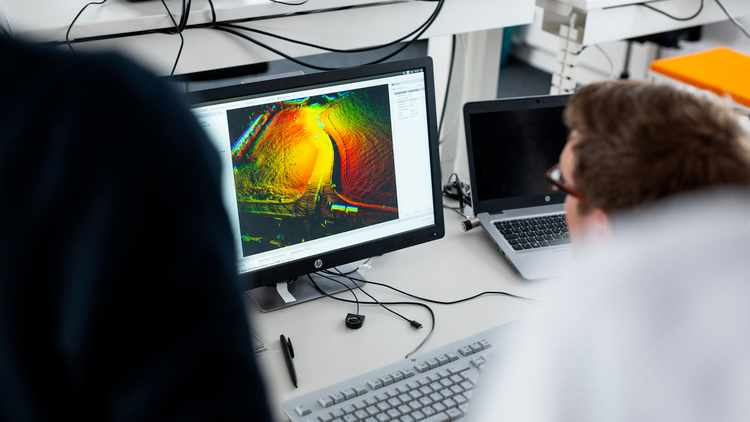
Simulations play an important role in driverless car testing. (Photo: BMW)
2025AD: Simulation seems to be seen as the magic tool to let cars learn. But where are the limits? What cases can be simulated and what cases need to be tested in real-world driving situations?
Wisselmann: The validation of autonomous cars therefore requires the usage of all today’s methods in a new combination:
Overall, this mixed approach based on a mix of experiments and simulations ensures that we fulfill our enhanced safety targets in real life traffic later on.
2025AD: When it comes to real-world testing, where on the planet do you test the different driving scenarios or road and weather conditions?
Wisselmann: It is necessary to test autonomous cars in every market. Every country is different with respect to traffic rules, traffic signs, driving style of the human drivers, weather conditions and so on. This leads to an enormous effort – but we are used to enormous efforts from the development of ADAS.
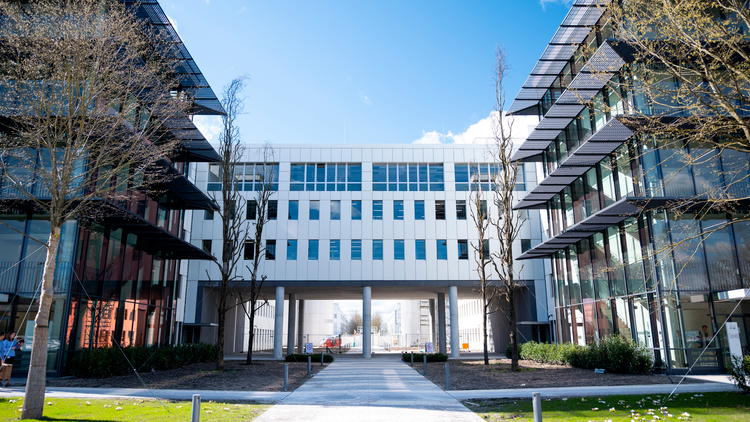
BMW opened its autonomous driving campus in Munich a week ago. (Photo: BMW)
2025AD: At first glance, BMW’s iconic claims like “Freude am Fahren” or “The Ultimate Driving Machine” seem to contradict the idea of automated driving. How does BMW resolve this?
Wisselmann: „Sheer driving pleasure” will not end until a BMW has no steering wheel. This will be the case with urban people movers. But these robotaxis in their first generation will not be able to drive over rural roads with the required speed. That means, level 4 cars with a steering wheel will exist for a long time – maybe forever? – so that the human driver is able to drive by himself, if he wants to. Therefore “sheer driving pleasure” will remain a part of a BMW – on driver’s demand!
2025AD: What do you see as the next big technological step in automated driving development?
Wisselmann: In times where no highly automated car is available on the market, it is an interesting topic to think about the future development. I personally believe that the consideration of basic human properties and needs will remain an important factor for differentiation in the automobile market. A car today is a means of transportation, a sport-device, a place for cocooning, a prestige object and so on. A company who is able to implement these factors into the product development process may have a competitive edge on the market.
2025AD: In the future, how will you personally spend your free time in your self-driving BMW?
Wisselmann: I’m an enthusiastic motorcyle rider and I‘am dreaming about a fully automated BMW car which is able to transport me and my oldtimer-racing BMW to a race track so I can do some fast laps - on my own.

This article was produced by 2025 AD, the original artical can be found at: www.2025ad.com
About our expert:
Dr.-Ing. Dirk Wisselmann studied mechanical engineering at the RWTH Aachen. Since 1986, he has been working for the BMW Group in the thematic areas of motorcycle-vehicle-dynamics, vehicle physics and driving simulator. From 2003 to 2011, he was head of research advanced driver assistance systems. He went on to become head of product offer advanced driver assistance systems. Since 2013, he has been Senior Consultant Automated Driving.
While much of the sector’s attention is currently on solving autonomous vehicle driving issues and city transit use cases, other industries are beginning to pay attention to how fully autonomous vehicles may impact their operations and long term viability.
While much of the sector’s attention is currently on solving autonomous vehicle driving issues and city transit use cases, other industries are beginning to pay attention to how fully autonomous vehicles may impact their operations and long term viability.
One such industry is local tourism.
Within single-day sightseeing, motor vehicles are primarily used for:
Local sightseeing tour businesses expect to use luxury vehicles for 5 years from new and achieve 15 years use for more robust busses such as used in cities. They also expect to have a resale value after this time.
When you compare this usage expectation to expected timelines for mainstream operation of autonomous vehicles within cities the scale of the problem faced by sightseeing vehicle operators becomes clear. They need to keep buying regular sightseeing vehicles (as that is what is on offer) but with the knowledge that they are not going to get the full usage that they need for commercial viability.
Furthermore, the styles of sightseeing tour that can be delivered autonomously are not the same as the mainstream tours on offer currently. Autonomous vehicles are not just a change in technology leaving the existing tours unaltered but an existential threat to existing operators that requires their full attention.
New experiences
Current tour experiences are tour guide and/or driver lead and tend to be designed for mainstream interest. Primarily this is because a tour has to achieve at least 500 bookings a year for commercial viability (to cover costs of training human tour guides to deliver the tour, to advertise and promote the tour to customers and travel agents).
Digital delivery of experiences (as can be achieved in autonomous vehicles) enables us to design tours with a lower required annual booking total before reaching commercial viability. This introduces a whole new class of tour experience that cannot be commercially delivered today.
For example a tour could be designed taking people to places related to a particular sports team. If it only attracts 50 customers a year, this would still be commercially viable. These new sightseeing experiences will be highly attractive to those with an interest in that sports team, but of little (zero) interest to anyone else.
This will accelerate the shift from mainstream sightseeing (that millennials are rightly rejecting) towards long tail, highly lovable (highly hatable) experiences. A shift that existing sightseeing operators may struggle to handle alongside the shift to autonomous vehicles.
New vehicle sizes
Autonomous shuttles with capacity for 6-8 travellers will be perfect for family sized groups. This is quite different to current tour coaches (for mainstream tours) with capacity for 30-50 people or even minibuses (which are twice the size of shuttles).
As such, experiences will be personalised (either to an individual or to a couple or a family), again a stark change from current generation mainstream tours with little personalisation in service.
This shift in vehicle size will create challenges at top attractions that are already very busy with vehicles dropping off, waiting & picking up. Existing tour coaches may be replaced by fleets of autonomous shuttles, causing significant congestion issues. This is a problem that will need to be addressed by attractions in the future, probably via expensive architectural reconfiguration of car-parking space and welcome areas.
While on the topic of vehicle sizes - for sightseeing - we really need open top if possible. I haven’t seen any open top autonomous shuttles yet. Is this because customers may jump out when underway? If so, would like vehicle engineers to take a look at this problem.
New curators
Currently tour companies act as the taste curators within a city, choosing what to visit and how long to stay. Due to the shift to digital delivery of experiences, we can expect influencers (or tastemakers) to be able to create their own routes. i.e. someone interested in craft beer would design a beer tour route.
Travel brands rather than vehicle brands
I expect in a few years time you will be taking a sightseeing experience in an autonomous vehicle that will be branded as booking.com, Expedia, CTrip, AirBnb, Uber, Lyft or TripAdvisor. These brands will take the lead for two reasons:
Potentially some of the leading hotel chain brands may also be full-service travel agencies by the time autonomous vehicles are everywhere. In particular Marriott and Accor both are becoming rapidly digital aware so could be contenders.
I do expect existing sightseeing operators to be part of the overall makeup of the new autonomous vehicle sightseeing market. This is primarily because one asset they all have is well positioned vehicle maintenance yards. Autonomous vehicles used for sightseeing will need regular cleaning to keep them operational and brands entering this market will require expensive land that existing vehicle based sightseeing operators already have.
Autoura
Autoura is a new platform for the creation and management of autonomous vehicle sightseeing routes.
We will provide sightseeing tour routing data and attraction booking capability to vehicle manufacturers (and other travel industry brands) for incorporating into vehicle based user interfaces and smartphone apps.
Find out more at www.autoura.com or come to the TaaS conference in July.
Biography (Alex Bainbridge)
CEO / CTO Autoura
Alex has 20+ years working in the tourism sector with over 15 on the technology side of the sightseeing business.
His last startup, TourCMS, was the early leader in tours & activity availability data and booking capability distribution - when you booked a local tour or sightseeing experience via leading online travel agents such as Expedia or TripAdvisor, it would likely be using TourCMS supplied data and connectivity.
He sold TourCMS end of 2015. His new venture, Autoura, is a platform for managing sightseeing experiences delivered by autonomous vehicles and other mobility platforms such as bikes & scooters.
Twitter @AutouraHQ
Automated driving may be a novelty to most, yet automated flying has been a standard for more than 20 years. Take a long-distance flight from Munich to Shanghai, for example. While the trip takes 11 hours, pilots fly the aircraft manually for as little as one minute on average. For the rest of the time, the plane flies automatically.
The autopilot kicks in shortly after take-off. En route, the aircraft is guided by the flight management system until the autopilot begins the descent into Shanghai Pudong Airport, supported by the airport’s instrument landing system. Once the aircraft has touched the tarmac, it is slowed down to a pre-programmed speed (“break to vacate”) so it can exit the runway on the pre-defined taxi way. In an ironic twist, the pilot then “drives” the plane to the gate.
Safer than flying the plane manually, such a level of automation also makes the journey more comfortable and more profitable. Yet this is a non-linear development; more automation does not automatically increase safety, comfort and profits. To achieve this, air travel needs:
Without these or similar features, automated traffic systems are liable to suffer uncontrollable failures. Undefined traffic situations are likely to occur and operators are at greater risk of committing serious mistakes, causing a situation in which they are unable to re-establish the safe operation of their vehicle.
Complementary features
To close potential gaps, safety features also need to be redundant. This guarantees that air traffic as a system remains secure even if parts of it fail. The loss of contact with air traffic controllers, for example, does not impede a plane’s ability to fly safely, even in adverse weather, as on-board instruments and established cockpit procedures ensure pilots’ control of the aircraft. Consequently, an aircraft is at risk only when two safety features fail simultaneously:
For automated driving, this means that an autonomous car without external safety features can be detrimental to overall reliability if operators do not fully understand the state their vehicle is in. The problem is known as the “ironies of complex automation” and was widely researched in the early 1980s. Placing an untrained driver in a sophisticated automated car meets all aspects of the phenomenon.
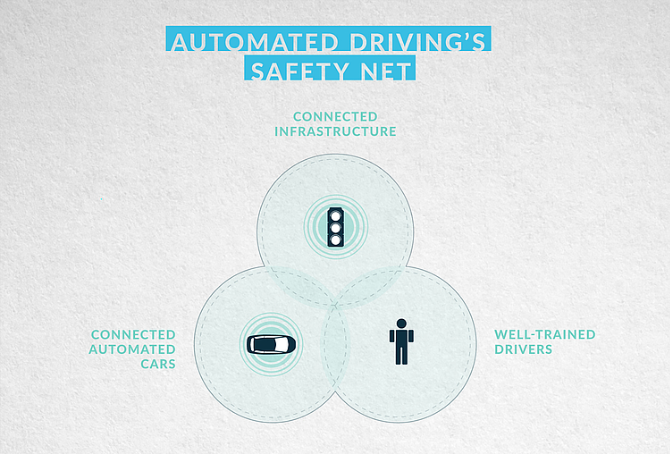
The automated driving safety net
The human risk factor
So how can these insights from aviation help the automated driving community?
Much like airspace, ground traffic is governed by rules, standard procedures and is supported by features such as cruise control and distance meters. While the basic approach is similar to aviation, the level of standardization is lower and drivers have significantly more wiggle room for individual decisions. Additionally, drivers’ ability to handle their vehicle in a challenging situation will likely decrease as automated driving technology becomes more advanced.
This creates a significant risk during the transition phase from partially to fully automated driving: the interaction between unskilled humans and highly complex machines rather reinforces the ironies of automation and hence lowers the level of operational safety.
The automotive industry therefore faces significant challenges on the road to fully automated driving. As of today, responsibility for safe guarding the system’s integrity rests almost exclusively with the vehicle. There are no additional safety features such as traffic guidance systems or rigorously standardized operational procedures for drivers. Compared to aircraft manufacturing, the automotive industry is also subject to relatively few regulations. It is therefore crucial to establish additional safeguards as soon as possible.
We also should re-organize public space to increase safety. Standards and regulations need to be communicated to vehicles automatically so cars, not drivers, follow them. The automotive industry is well advised not to rely on measures that raise drivers’ skills to a level comparable to that of pilots. Rather, automated cars should offset the shortcomings of human operators (cognitive automation).
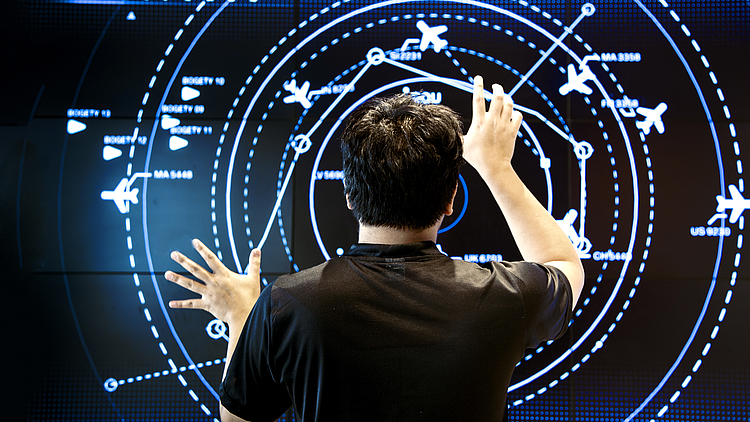
Automated cars should offset the shortcomings of human operators (Photo: Adobe Stock)
Close the front door
Untrained drivers should have no control whatsoever over highly complex means of transportation. The only safe alternative is to put drivers into the backseat where they can enjoy the ride as passengers. If automated driving is to be successful, it is crucial to establish a “closed cockpit” where passengers have no influence on the vehicle’s operation.
The success of automated driving will hinge on automated systems’ ability
As soon as automated vehicles gather input to act independently, their interpretation of a given scenario will become incomprehensible to humans. Translating the machine’s behavior into a language that we can understand will only be possible at the beginning of automated driving – and even then, it will be an onerous and error-prone task.
Out of the loop
Still, the machine’s strategy will be optimal in most scenarios and certainly better than a human driver’s approach. We are therefore well-advised to limit human intervention. The man-machine interaction should be confined to entering a destination and a time of departure or arrival. Keeping humans in the loop of a deep-learning automated vehicle is next to impossible anyway. It will be our task to think about the consequences this will have on our ethics and norms.

This article was produced by 2025 AD, the original artical can be found at: www.2025ad.com
Alex Thibault is General Manager — North America for Vulog. He oversees Vulog’s operations on the continent, providing best in class technology to mobility services. Feel free to email him at athibault@vulog.com
Vulog provides sustainable technologies and business solutions to large groups and pure-players who want to securely turn theirshared mobility ventures into profitable services and to get into the game of autonomous mobility. http://vulog.com/
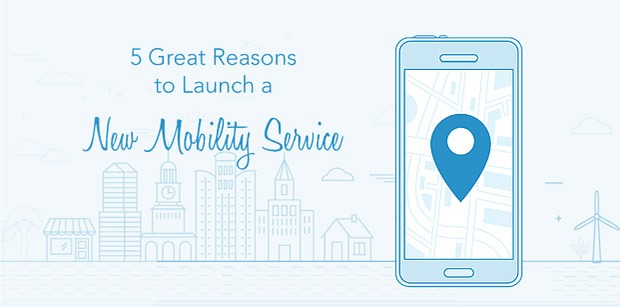
We are currently witnessing the early stages of a tectonic shift in the market for mobility services. Organizations small and large are diving in every week and becoming operators in a space they wouldn’t have necessarily considered ten years ago.
For a number of good reasons, car manufacturers and distributors, oil and gas companies, insurance providers, car rental operators and startups are each positioning themselves to grab different portions of a pie poised to grow exponentially in the next few years. Some of those reasons are the following:
1. Gigantic opportunity.
A McKinsey study published in 2016 concluded that new mobility services would generate revenues of USD 1.5 trillion in 2030, compared to USD 30 billion at that time. To give a reference point, the entire automotive market, including car sales and aftermarket products and services, currently stands at about USD 3.5 trillion and it took close to 110 years to create that much value. A 1.5 trillion dollar market will appear in about 15 years, representing a compound annual growth rate of 30% over an extended period.
Simply put, this could be one of the biggest opportunities we will see in our lifetime.
2. The shift from product to services in the mobility industry is only beginning.
Historically, the companies that have owned the lion’s share of the mobility space have been car manufacturers. Their growth was built on a model where individual car ownership was the de facto option, with the only day-to-day alternative being public transit in high density areas.
Now, ride-hailing services offer extremely convenient transport options around the globe and free-floating carsharing offers a cheap and flexible option for most commuters and people who need to get around a city. However, when a service like Uber has the worst public image period in its history and still reports that revenues are up 17% from the previous quarterand car2go reports utilization up 40% from a year earlier, one can only infer that the appetite for mobility services is still far from being satisfied globally. Very far.
3. People who don’t use new mobility services are likely to start using them.
Recent US data indicates, without much surprise, that house prices in US cities are growing faster than wages. In fact, in 80% of US cities, they are growing at twice the rate of wages and this isn’t a new phenomenon. Between 1940 and 2000, the median home price in the US went from $2,938 to $119,600, indicating that the fast increase in cost of housing is here to stay and that, inevitably, the amount of discretionary spending for the average household should diminish if all else stays equal.
The United States Bureau of Labor Statistics reports that transportation, including car ownership, is the second largest expenditure for the average consumer after lodging. It is also not nearly as high on Maslow’s hierarchy of needs for most city dwellers as the first expenditure (lodging) and the third (food). Therefore, it is only logical that people are increasingly looking to transport to shave some costs. As such, they are likely to use new mobility offerings if they are more economical and about as convenient as personal car ownership.
Until recently, this was only an educated guess. However, cities with developed new mobility options like Vancouver now give us a glimpse of the future, where urban populations will rise much faster than vehicle count.
Vancouver now has about 3,000 shared cars, including 2 large free-floating services with more than 1,000 vehicles. Between 2012 and 2016, the city added approximately 10,000 cars (3.8% increase) for a population growth of about 33,000 people (5.2% increase), which means it added about 0.3 cars per new inhabitant over 4 years. This represents a 27% decrease over the 0.41 cars per person in the city in 2012. While this data alone isn’t enough to conclude that there is a correlation between that and the strong carsharing presence, we can infer that 27% more people will be likely to use new mobility services because they do not own a vehicle.
4. People who use new mobility services will continue increasing their usage.
According to a study conducted by McKinsey, 96% of carsharing users plan on either maintaining their use or increasing it in the next 2 years, with 67% planning on an increase, while 95% of ride-hailing users will maintain or increase their use. Therefore, it is still difficult to accurately predict what the Lifetime Value (“LTV”) of a customer is. The one thing we know for certain is that this LTV is trending upwards, which is a great sign for the industry.
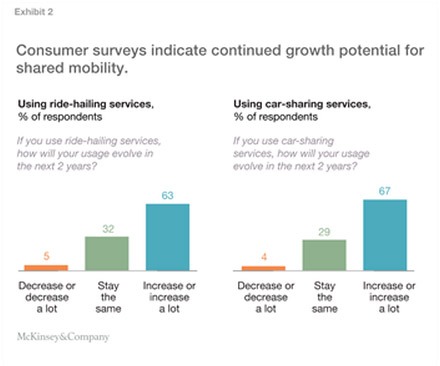
5. Technology is available and better than ever.
High end tech offerings are now readily available to power large mobility services. You no longer need to spend millions of dollars on technology, while making tons of development mistakes along the way, to get a service up and running. Today, a tech provider like Vulog offers a solution that powers over 10 million trips per year for dozens of mobility services around the globe. Therefore, the best features developed for projects all over the world are now baked into a platform that’s readily available and you get a partner with well over a decade worth of experience in the space as an added bonus. Not a bad deal.
According to Gartner’s 2016 Hype Cycle for Emerging Technologies report, autonomous vehicles on the streets in any meaningful way are about 10 years out, this being particularly impending in urban environments. So-called Connected & Automated Vehicles will be permanently connected - to the Internet, to other vehicles and the infrastructure through C-ITS - and be part of a much more complex, richer, mobility ecosystem / IoT network. Implications are manifold, and so are the challenges facing cities, transportation being a common, central topic.
The role of public authorities
Fully autonomous vehicles are likely to be too expensive for individual owners, and thus we’ll probably rather see them be part of fleets (both public and privately run), at least initially. In this respect, Public Authorities play a key role to progressively introduce new technologies, such as EVs or AVs, into the public transport system, therefore educating users into the benefits of such vehicles, and leading by example. Public transport operators in several early adopter cities are paving the way by piloting pioneering automated transit services – albeit restricted to very specific, controlled scenarios, sometimes using dedicated lanes with limited interaction with other vehicles, most often having drivers sit in the vehicles to resume control in case of failure of the system, and running at an operating speed that is still far from desirable in order to be competitive.
Robots hold out the promise of being better drivers than we are, therefore contributing to meet crucial “societal KPIs”, such as:
While it is widely accepted that AVs have great potential to enable a future perspective of fewer vehicles on the road, improved quality of the air, and more inclusive and liveable cities; assuming these outcomes can indeed convert into significant global economic figures (indirect benefits) for cities, and hence justify huge public investments and supporting related policies, private stakeholders in the transportation sector are not NGOs, and are in the market to be profitable (as every company struggles to, by the way).
New (and not so new) players
In my view, the principal weapon of private players in the transportation game is not (not only) super-complex AI algorithms or high-tech sensors (embedded in vehicles, sensing “smart” cities, etc.), but their ability to stay profitable and generate good recurring revenue… soon, and increasingly, with the inestimable contribution of automation.
Investors that have backed many of these companies have well understood this long time ago. It’s the only reason I see for them to keep investing indecent amounts of money into unicorns, like Uber, that have yet to (and might never) deliver. I guess the Uber case deserves a whole separate in-depth article, but it seems quite evident Uber is pursuing global industry dominance in a “winner-take-all” approach. I have never been fond of the idea of domination in any form, and I tend to be sceptical about Uber’s somewhat unrevealed strategy to turn the global transportation sector upside down by killing all their competitors, public transport included. I believe nothing of this will happen, neither with the help of driverless technology as the holy grail of it all.
At the same time, extremely interesting developments are taking place, in the transportation arena, with a more “democratic” spirit, such as “Mobility as a Service”. With MaaS, different mobility services are to be combined, in a seamless way, so that end users have a wide array of possible combinations to get from A to B, including Uber and the like (in the markets where they are allowed to operate, in any of their different flavours). While some analysts assert that Uber’s ability to capture customers and drivers from incumbent operators is mostly due to the 2 billion $ in annual investor subsidies (funding, among other, massive publicity and awareness campaigns), MaaS entrepreneurs should gain user traction and positive word-of-mouth by delivering a truly compelling mobility offering that includes car / bike / scooter shares, carpools, car rental, car leasing, demand-responsive transit services, etc… and, ideally, public transport as the backbone. MaaS’ Unique Selling Proposition is consequently not only about convenience of use (an Uber car in every corner of your city ready to be hailed at a tap might be convenient for many users), but also fair, affordable and transparent pricing of mobility. Hence public-private cooperation is fundamental, so that the interests from the consumers will be protected, and public policy goals fulfilled. Imagine a future transportation scenario that would be dominated by Uber under a kind of monopoly. It is very probable that users would suffer from an out of control surge pricing (urged by the investors claiming their money back… multiplied by X).
No doubt an ecosystem approach for mobility is the best possible scenario going forward. With various Mobility Service Providers coming into play, and a MaaS layer on top - including easy trip management, booking and payment -, competitive fares and freedom of choice will be fostered, contributing to make users’ lives easier. This way, the MaaS operator will become a new player that “connects the dots”, generating value for the MSPs that are integrated under a given mobility offering (by attracting new customers to them), and naturally for the end users, by providing more alternatives for seamless mobility. The ultimate realisation of the MaaS business model would also include providing new complementary services to the traveller (such as location-based services).
Very interesting is how so-called new urban mobility services (and new mobility paradigms, such as MaaS) are being pitched by their promoters. Whim app, by the Finnish company Maas Global, is often presented as “the Netflix of Transportation”; the Ubigo MaaS pilot in Sweden was labelled as “the Spotify for travel”; Turo, the American P2P carsharing firm, market themselves as “the AirBnB for cars”… And there are dozens of “Uber for X” startups out there, too.
In an era where access over ownership is becoming a global trend, entrepreneurs in the mobility space have well understood how to “educate” users on the access to the mobility services they need by “comparing” themselves to well-known brands of the so-called collaborative economy. This is of course all marketing buzzwords, and it works well for this purpose, but the transportation sector has nothing to do with movies, music or renting apartments (I tend to think it’s a much more complicated sector, but I assume I probably have a biased view on the subject).
Even if they are able to attract private investment, companies developing MaaS will struggle to thrive, partly because of the lack of money budgeted to update public transport legacy systems, old-fashioned procurement approaches and, more painfully, often due to a lack of a shared vision and political involvement towards future mobility, that should ideally combine privately-run mobility services with public transport in order to be attractive enough for the travellers. Moreover, revenue for MaaS operators will probably not come from future deals with public transport operators, which are most often loss-making and highly state-subsidized. The goal should rather be to get public transit authorities understand they should not avoid cooperating with other mobility entrepreneurs in order to stimulate the market of new mobility services, and for the ultimate benefit of the citizens they serve.
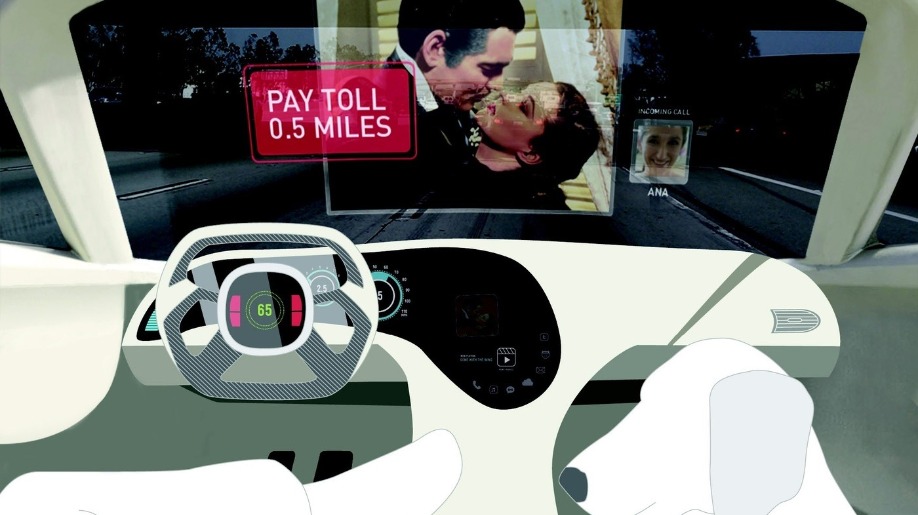
Image credit: Jiha Hwang _ Illustration from “The Car in 2035: Mobility Planning for the Near Future”
Driverless technology undoubtedly a promising technology but…
Back to driverless technology and adding to the “societal KPIs” mentioned before. Some positive factors or opportunities to consider, business-wise and from a MSP perspective, are:
Notwithstanding, drawbacks or hurdles for the wide adoption of AVs are not negligible. Besides the commonly acknowledged legal, regulatory, safety, liability, data privacy, user acceptance, and technological issues, worth mentioning also are:
After all, despite my criticism before about Uber’s business model and overall growth strategy, I think it’s great news this startup (now unicorn) popped up to revolutionise the transportation industry, pioneer and sort of lay the foundation of a more diverse, more technology-enabled, people-powered, user-centric and customized travel experience. The challenge will be to get users not to #deleteUber and public authorities to find a good fitting for all these new mobility services with an improved public transport system. Will that be MaaS? The business model will tell!
Automakers at a tipping point
It’s little wonder that automakers aim at having a say on this all, too (let’s not forget they have for long been the main providers of personal mobility!). The transformation of cars into electric and fully autonomous vehicles in the coming years, combined with the business model shift from car ownership to utilizing the shared economy is already upending not only the auto industry, but also have profound implications for the finance, insurance and real estate sectors. Automakers have well understood business is not any longer only (or mainly) in building and selling cars (plus some after-sales service), but rather in the provision of services around the “mobility experience”, that is becoming much richer (there will be more to do and consume while travelling), more technology-enabled, less (privately-owned)-car-centric, and more intermodal. It all demands a fundamental mind shift for automakers to go beyond their traditional product and service focus, understand they are now part of a public-private mobility ecosystem, need to forge new alliances, and must play their (renewed) strengths in this new scenario, with new rules and more diversified players.
Automakers are embracing two main different strategies matching the demand of the connected consumers in this new level playing field:
[Shifting into MSPs] by:
[Providing vehicles to other MSPs], becoming suppliers to car-as-a-service fleets run by the Ubers out there, trying to secure some market relevance by partnering with them (risky move, as all SLAs and the interface with the customer, including payment for the mobility services, will be controlled by the MSP, with the car being not more than a “commodity”, something to which automakers are certainly not used to, to say the least). If Uber, Lyft, Google and the like retain a good share of customers demanding mobility services, and if these imply driving (or riding in) cars, these cars will still have to be built by OEMs. Increasingly, OEMs are “obliged” to let other brands in “their” vehicles, interacting with “their” customers (not their sole customers anymore, I’m afraid). Users demand connectivity; they love their iPhones and Android phones, and are so used to their interface and favourite apps; and there you have CarPlay and Android Auto, as a result. It’s very simple logic, in fact. OEMs want to retain customers, one way or another. And they will want you to use Uber in a car of their brand, not in a car of their competitors. With Uber (and Lyft, etc.) placing big bet on automation, OEMs will become providers for these automated fleets (because private drivers will not own driverless cars).
Autonomous vehicles not a fad
Automated cars hold great potential for generating new revenue streams. Following are some hints on what is relevant, some key factors or elements to put the focus on:
All in all, if man landed on the moon almost half a century ago, then it’s not really all about technology. Legal and policy stuff is ultimately about reaching agreements, and that’s something that human beings have been doing for ages. The transportation of the future will be basically shaped around, and determined by business models capable of generating revenue while flexibly responding to the (new) needs and demands of the users. If the users get the mobility they demand, they will adopt new technologies, and pay for them. The necessary legal framework and amazing supporting technologies will no doubt follow, including super clever driverless vehicles to make our lives easier. Those that understand the rules of this game will succeed. So let’s play!
About the Author:
Josep Laborda thinks mobility outside the box @ RACC Automobile Club and CARNET. Mobility not black and white: want both taxi and Uber in my app. Traffic information is sexy. He writes fiction, besides technical stuff. Future mobility often sounds like sci-fi, which is great. He loves wine, human towers and photography (not necessarily in that order). More on him: check @josik35 at Twitter and Instagram or his website: http://www.joseplaborda.com. Grown-up, views are his own.
Transport as we know it is changing, and we are already seeing the first steps towards autonomous or ‘driverless’ vehicles, in the form of automated parking and emergency braking systems. But while these developments are taking us closer to an age of smarter, greener, safer transport, there remain numerous challenges to overcome, and not all of them are technical.
Critical success factors include gaining the public’s trust and acceptance of the technology, developing technical solutions that are affordable and dependable, and building appropriate ethical and legal frameworks to support new ways of operating.
WMG’s Intelligent Vehicles research team, led by Professor Paul Jennings, takes a multi-disciplinary approach to research on connected and autonomous vehicles. Our work spans many areas, including co-operative autonomy, wireless communications, verification and validation, human factors, cyber security, new business models and driver health/monitoring.
Our activities are underpinned by a unique facility, a drive-in, driver-in-the-loop driving simulator (3xD). The simulated environment provides the automotive industry with novel facilities for virtual whole system level design, and testing for sensors, wireless communications and other new technology.
The 3xD simulator will become the centrepiece of the forthcoming National Automotive Innovation Centre (NAIC). Due to open in October 2018, NAIC will be the largest research centre of its kind, enabling industry to work side-by-side with academics on leading research to deliver exciting new products in the areas of Connected and Autonomous Vehicles (CAVs) and Advanced Propulsion Systems.
WMG is at the forefront of accelerating future mobility solutions, leading a £25m programme of investment to turn roads in Coventry and Birmingham into a world-class environment for developing next generation CAVs and related services. Undertaken by a consortium of research and industry partners, Midlands Future Mobility will make UK roads ready for CAVs by providing the necessary infrastructure, and analysing how vehicles behave in real urban environments, and carrying out public evaluations. Over 50 miles of urban roads will be used, creating a world-leading connected infrastructure and eco-system, and positioning the Midlands as a centre for accelerating the introduction of new mobility technology and services.
To learn more about how we are applying our innovative research to real-world challenges, visit our website www.warwick.ac.uk/wmgautomotive
Transportation-as-a-Service (TaaS) Technology Conference is a two-day global conference and exhibition dedicated to covering the key topics of the Connected & Autonomous Vehicles (CAV) and Future Mobility industry and it will take place on July 9th and 10th 2018, The Slate, Coventry, UK. The TaaS Technology Conference will bring together international experts for two days of in-depth discussions and exhibits focused on the opportunities and challenges of a mobility future that leverages CAV and TaaS technologies.
Attendees to the conference will hear industry-leading insiders delivering more than 40 presentations spanning eleven key topics. The conference will equip the delegates with an up-to-date overview of the status of the CAV and TaaS industry, and provide them with many opportunities to meet other key players within this community.
The event is being organised in partnership with Coventry City Council, Coventry University and WMG, at the University of Warwick and has attracted an array of leading international experts.
Speakers include: Autosar, AXA Insurance, ARUP, Coventry University, European Investment Bank, Ford Motor Company, HMI Technologies, IBM, IHS Markit, In Motion, Jaguar Land Rover, Local Motors, KPMG, MaaS Global, MaaS Alliance, Microsoft, Nokia, NVIDIA, Orange, Pinsent Masons, Ridecell, SAP, SBD Automotive, SAP, TRL, Thales, TomTom, UBER and Vision Mobility.
With only a maximum of 250 delegate places and 20 exhibitors, the conference is almost sold out. With less than 4 weeks to book your place, less than 30 delegate spaces left and only 2 slots in the exhibition - book today to make sure you are at the must-attend CAV and Future Mobility conference of 2018!
David Fidalgo - Y-mobility
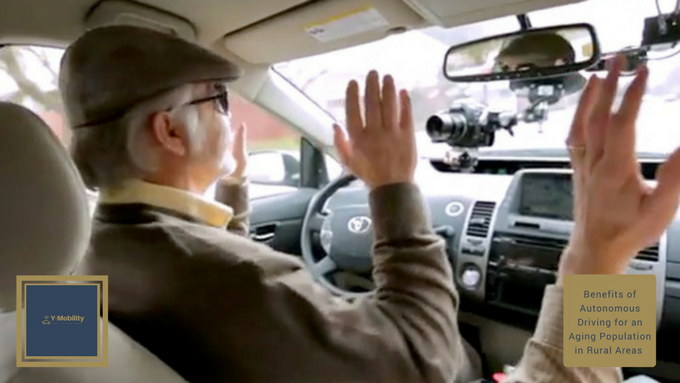
Nowadays, most mobility & autonomous driving technological advantages and trends are developed with a focus on the millennial, (Generation Z and Generation X) living in the cities with a high necessity for solutions that provide them time for themselves and comfort. Technological advantages are trendy these days and sometimes we tend to forget what these technological solutions are trying to achieve. Improve our lives and make a difference to as many people as possible.
As we are on the subject of autonomous driving and mobility solutions, everybody has a generic picture of a tech person in a city environment using all these services and being the first one to adapt the technology. It is hence already embedded in our mind that when you read or hear about Mobility solutions, people will automatically think of autonomous vehicles in a city environment. However, let’s stop for a moment and analyze the target consumer and the early adopters of these technologies.
Autonomous driving is more than just the means of enabling a smarter, more Intelligent mobility. Intelligent mobility is a service focused in the community and their ability to share, collaborate and communicate in order to develop a way of thinking and behavior as a community.
Early Adopters
According to the big four consultancies (PWC, McKinsey, Deloitte, KPMG) and many others, the early adopters of a technology are the ones that would embrace this technology because they foresee that it will provide a solution that improves their lives, financially and not only. If we review most of these studies, all of them point to the fact that the early adopters of autonomous driving technologies are disabled people (usually with vision disabilities) and elderly people in rural areas.
Roland Berger recently published a study that demonstrated an in-depth analysis of the market, demographics and the social benefits that some of these technologies have had. According to the study, the global average of 65+ population in 2060 will be 30-35% in China, Singapore, Italy, Germany and South Korea and up to 40% in Japan. The study also show the distribution per county of the rural population on 2015, see below:
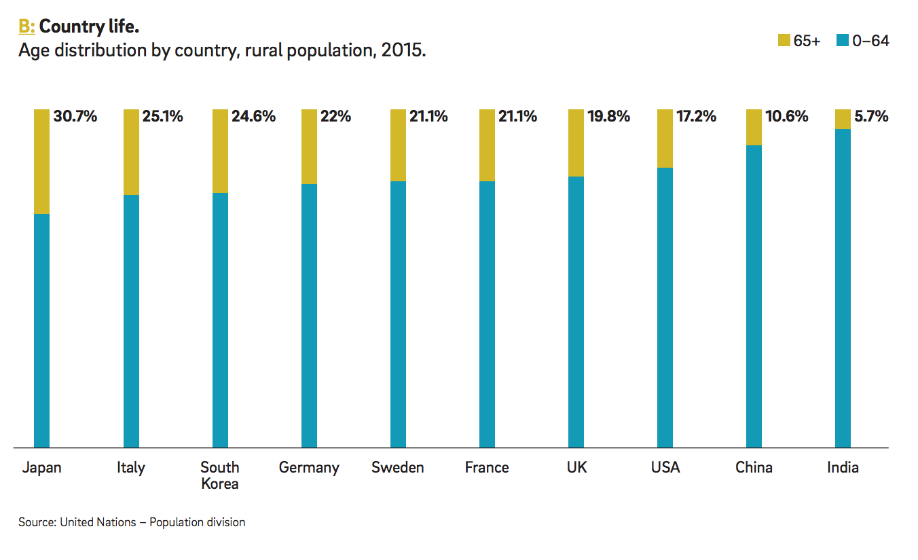
It is very evident from the above that the elderly population (especially in rural areas) are a key users of these technologies and the benefits that they can gain from them can be life changing.
Benefits of the integration of autonomous driving in rural areas:
Impact in Health and happiness: We all have family most of us in rural areas. Some of our relatives don’t drive anymore and they are dependent of family or friends to do normal tasks like shopping, going to the doctor, etc. It is consequently clear that Autonomous technologies can help them maintain that independence which in turn can have an enormous impact on one’s confidence and life overall. In addition, it allows them to continue their social interactions and relationships with their loved ones and local community having a tremendously positive impact on their happiness and health.
Reactivate communities in rural areas: Some of the rural areas are isolated due the lack of public transport and despite the fact they have good road networks. Opening up transportation between rural areas will allow communities to intermingle and reconnect.
Increase Mobility and Technology Adoption: Some of the rural areas do not have the ability to be so “technologically savvy”. Internet can be poor, infrastructures are not up to standard and smart devices are not exactly ..popular there. The integration of these technologies in rural areas would speed up the adoption of these technologies and would also provide insightful feedback to tech companies for that demographic of society.
Sustainability: Most of the POD’s and autonomous driving vehicles are going to be electrical. At the same time rural areas are the ones with high use of older vehicles and not environment friendly, so the adoption of these technologies would also contribute to “greener” solutions and much more environmentally friendly solutions. The movement from Diesel to EV..will have began.
Conclusively, it is very clear that the autonomous driving and intelligence mobility industries, are key in rural areas. Nonetheless – and as I operate in the industry daily – I am not aware of any such initiatives apart from Waymo in USA that are currently working on a very interesting project. According to the pre-mentioned study above, it is clearly a market that would substantially benefit from autonomous technologies and I hence believe (and hope) more companies will soon engage a lot more actively.
Final Personal Note:
I have personally worked in the sector for years and am a firm believer that technology is there with a sole purpose. To improve our lives. I would thus encourage both governments and technology companies to push the boundaries and invest more in time and money in rural areas sooner rather than later. As a company with vast experience, here at Y-mobility we would be happy to support and assist any new project that focuses in the above area.
Technology contributes to our Happiness and achieving Happiness through Technology is our primary goal.
Article by David Fidalgo
http://y-mobility.co.uk/benefits-of-autonomous-driving-for-an-aging-population-in-rural-areas/
Subscribe to our blog for free, click here to arrange a FREE Consultancy meeting, send me an email at Dfidalgo@Y-Mobility.co.uk or Follow me below on Facebook, Twitter, LinkedIn and Instagram.
By Stacy Janes, Chief Security Architect, Irdeto
The rapid innovation in connected and autonomous technology has been impressive in recent years. Driven by consumer desire for simplicity and customization, connected devices and services have begun to touch upon almost every area of daily life for many of us. This has now extended into the connected vehicles we see today and, will inevitably be a key facet of the increasingly autonomous vehicles of the future.
Indeed, autonomous vehicles are rapidly becoming a reality and there is a clear drive by all parties in the value chain (manufacturers, tier one suppliers, consumers and even regulators) to make this happen sooner rather than later. In February, Waymo, Google’s self-driving car company, was given the go ahead to launch a fully autonomous taxi service in Arizona later this year, and General Motors chief technology officer, Jon Lauckner, recently revealed that the OEM would launch an autonomous vehicle in 2019. Not to be outdone, on the other side of the globe, Tencent was in May given the go ahead to road test autonomous cars in Shenzen, China.
Perhaps more surprisingly, regulators across the globe are just as focused. In the US, the State Department of Motor Vehicles in California recently announced that self-driving cars backed up by a remote human operator could be tested on roads in the first half of this year. Meanwhile in the UK, the Chancellor announced as early as the November 2017 budget that there would be regulation changes, with a view to having driverless cars in operation in the UK by 2021. Similarly, the EU is aiming to catch-up with China and the US on the self-driving vehicle front, announcing just last month that it would develop rules for autonomous vehicles.
It’s also clear that many consumers cannot wait to get their hands on a fully autonomous vehicle. So much so, that we frequently see reports of drivers relying on driver-assist functions as fully autonomous systems, with dangerous results. So, while speed seems to be the main concern on all sides when it comes to the development of autonomous vehicles, all parties must understand that this technology cannot become a reality safely, without robust security in place.
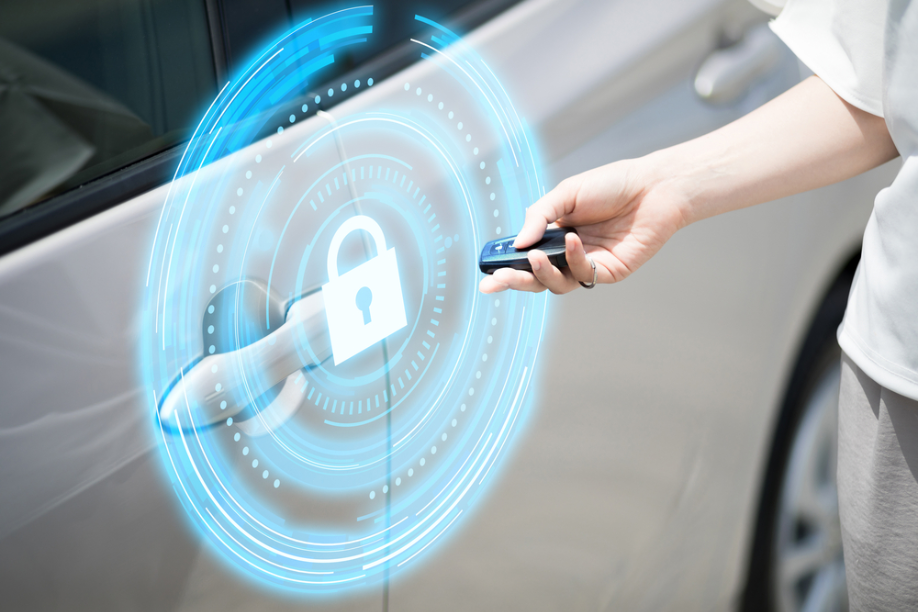
Understanding the threats
Unfortunately, eagerness for connected technology in some industries has resulted in security becoming an afterthought in many cases. It is crucial that this does not become widespread across the autonomous transport sector, as retro-fitting security will be a much tougher job than building it in from the ground up.
However, the simple fact is that there are always vulnerabilities present in connected systems and connected and autonomous cars are no different. Hackers continuously evolve their attack strategies and have exploited vulnerabilities to access vehicle electronic control units (ECUs), controller area network (CAN) bus systems, intelligent transportation systems (ITS) or even automotive apps through the cloud. Potential attacks also include Man-in-the-Middle and Man-at-the-End attacks, remote and in-vehicle tampering, and reverse engineering.
These security concerns must be addressed by the industry and this is made even more important by the fact that an awareness and level of concern exists among global consumers about the security risks associated with connected and autonomous vehicles. Irdeto’s recent Global Connected Car Survey of 8,354 consumers across six countries (Canada, China, Germany, Japan, UK and US) found that 85% of consumers believe connected cars could be targeted by a cyberattack and nearly half do not plan to buy one in the future.
In addition to concerns about the security of the vehicles themselves, as the number of connected and autonomous vehicles on the road grows across the globe, the ways the automobile communicates with its surroundings and other connected devices also increases. This means that protection of only the vehicle itself is not enough. OEMs must also consider the entire connected vehicle ecosystem, including the security of the Road Side Units in V2X. This is because they will not be able rely solely on the security of the communication itself as the attack may come from the end-point.
To address the vulnerabilities, a well-defined strategy is required where OEMs, tier-one suppliers and IT service providers work together to not only define cybersecurity solutions, but more importantly, understand vulnerabilities from a hacker’s perspective. However, while understanding both threats and risks is a good starting point, to be successful in the long term, new practices will have to be adopted.
Enabling new secure business models
Going back to the consumer needs in connected and autonomous transport, the bottom line is that they expect simplicity, convenience and customization from any digital service, and vehicles are fast becoming a part of this expectation. The ability to use a mobile device and companion application to eliminate the need for physical keys to a car is a reality, and functionality is only accelerating from there, such as enabling policy-based driving scenarios. It’s also already clear that consumers expect to be able safely manage and operate today’s connected vehicles with even more simplicity than is currently available or even safe. As a result, secure tamper-proof software is crucial for OEMs and tier one suppliers to provide the benefits that consumers expect in a safe and secure way.
While the security threats outlined earlier must be taken seriously by OEMs, they should also consider the opportunities for new revenues and business models that can be built from the basis of a secure platform. As vehicles become increasingly connected and autonomous, OEM business models have the potential to shift and the continuing evolution means that we could see a move from personally-owned vehicles to a fleet model.
In this reality, implementing secure mobility-as-a-service and transportation-as-a-service business models will not be a nice to have, it will become essential to maintain a competitive edge. Therefore, protecting business data and securely enforcing policies assigned to the vehicle is crucial to allow business owners to deliver customizable experiences to their customers. In addition, OEMs must have the ability to securely manage and control services offered in the vehicle. As a result, these new business models can only be enabled if they are built on security as a foundation.
The bottom line is that connected and autonomous vehicles as digital assets are creating more opportunities for OEMs and tier 1 suppliers, from new business models to improved safety. However, it is imperative that vehicle manufacturers balance safety while implementing a convenient, flexible and customizable driving experience for consumers operating today’s connected vehicles. It is strong security that will provide the basis to create these profitable new business models while delivering compelling and exciting new experiences for consumers.

Stacy Janes, Chief Security Architect, Irdeto
Stacy is the Chief Security Architect for Irdeto’s automotive security solution, Cloakware for Automotive, which he is also the founder of. Stacy brings over 20 years of experience from the software security industry both as a software developer and ethical hacker. He has had exposure to several security technologies throughout his career as a PKI developer for Entrust Datacard (formerly known as Entrust Technologies) and as a consultant to the Canadian Government specializing in security and authentication systems. He also has extensive experience in threat analysis and penetration testing.
Stacy Janes has a Bachelor of Computer Science from Acadia University and is the team lead for the GENIVI security expert group.
Transportation-as-a-Service (TaaS) Technology Conference is a two-day global conference and exhibition dedicated to covering the key topics of the Connected & Autonomous Vehicles (CAV) and Future Mobility industry and it will take place on July 9th and 10th 2018, The Slate, Coventry, UK. The TaaS Technology Conference will bring together international experts for two days of in-depth discussions and exhibits focused on the opportunities and challenges of a mobility future that leverages CAV and TaaS technologies.
Attendees to the conference will hear industry-leading insiders delivering more than 40 presentations spanning eleven key topics. The conference will equip the delegates with an up-to-date overview of the status of the CAV and TaaS industry, and provide them with many opportunities to meet other key players within this community.
The event is being organised in partnership with Coventry City Council, Coventry University and WMG, at the University of Warwick and has attracted an array of leading international experts.
Speakers include: Autosar, AXA Insurance, ARUP, Coventry University, European Investment Bank, Ford Motor Company, HMI Technologies, IBM, IHS Markit, In Motion, Jaguar Land Rover, Local Motors, KPMG, MaaS Global, MaaS Alliance, Microsoft, Nokia, NVIDIA, Orange, Pinsent Masons, Ridecell, SAP, SBD Automotive, SAP, TRL, Thales, TomTom, UBER and Vision Mobility.
With only a maximum of 250 delegate places and 20 exhibitors, the conference is almost sold out. With less than 4 weeks to book your place, less than 30 delegate spaces left and only 2 slots in the exhibition - book today to make sure you are at the must-attend CAV and Future Mobility conference of 2018!
Author: Dr Dan Yanson, CEO, TheWhollySee
AI kills
AI can kill if given tasks beyond its intelligence – or beyond the level of training it received to do its job. The case of the poor woman run down by an autonomous Uber vehicle in Tampa, Arizona, in March this year, is still fresh in everyone’s minds. Much speculation arose as it what caused arguably the first human casualty at the hands, er, wheels of AI. Just recently, in late May, the US National Transportation Safety Board released a preliminary investigation report, which boils down to a succinct headline, “the sensors worked; the software utterly failed.” As if driving with the emergency braking disabled wasn’t bad enough, the report paints a damning picture of the object detection performance by the vehicle’s environmental perception AI:
"As the vehicle and pedestrian paths converged, the self-driving system software classified the pedestrian as an unknown object, as a vehicle, and then as a bicycle with varying expectations of future travel path," the report says.
This goes to show how important the classification of objects is, because each object class has its own properties that determine its possible travel paths. In reality, an autonomous vehicle must be able to detect and correctly classify each and every object present in a complex scene. In AI / computer vision jargon, this is known as instance-level object understanding, which dictates that all instances of a class (e.g., cars) must be detected, located and identified in an image produced by the specific imaging sensors (cameras and LiDARs) mounted on the vehicle.
Why training matters
So what was wrong with Uber’s image understanding AI? The short answer is, training, or rather, lack thereof.
Environmental perception of autonomous vehicles is powered by deep neural networks that need hundreds of thousands, if not millions, of examples to learn the appearance of common and not-so-common objects that they could possibly encounter in real-world traffic. For supervised machine learning, you need lots of annotated, or labelled data, meaning an image with object labels and the precise pixels occupied by those objects. The labelling of the different objects and areas in an image by class is referred to as semantic segmentation, and the labels and corresponding object locations as “ground truth.” Large, diverse, high-fidelity training datasets are essential to autonomous vehicles using deep learning for scene understanding.
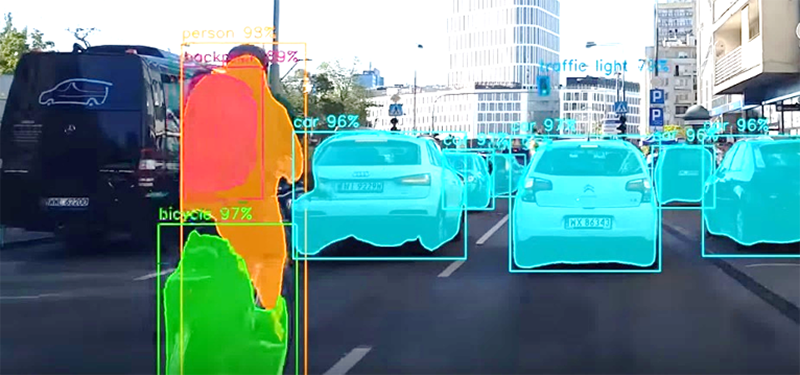
Fig.1. Object detection by a state-of-the-art neural network.
The coloured shapes in Fig.1 show the objects recognised by a state-of-the-art neural network, which failed to detect a particular van – perhaps because it blends in with the road surface. So this network needs to go “back to school” for further training to learn what vans look like. The same goes for Uber’s AI, which needs to be schooled with a few thousand more images of pedestrians crossing a road at night. And do so through the eyes of specific sensors on the vehicle – visible light and night-vision cameras and LiDARs, so training datasets are needed for all these different imaging modalities. Then through sensor fusion one can combine the strengths of the different sensors to build an accurate worldview around the vehicle.
AI training datasets
How is AI training done today? Neural networks are usually pretrained on synthetic data, which are obtained from VR simulators of proxy worlds driving virtual cars. This approach entails significant 3D modelling effort to build proxy worlds and lacks both photo-realism and diversity. Actually, one can get very photo-realistic scenes that almost look like the real thing as in Fig.2 (left). Almost, but not quite – which why one needs to complete the training on real-world data that contain low-level detail and physical sensor effects. Real-world data contain sensor bias (e.g., aberration, blur, exposure, noise) but require manual human labelling to generate “ground truth,” which is tedious and slow (up to 1 hour per image). The preparation of hand-labelled data as in Fig.2 (right) is usually outsourced to cheap labour countries like India and Bangladesh. Still, labelled real-world data is very expensive and costs up to $10 per segmented image.
Both the synthetic and real-world data have their pros and cons, and are used in a complementary fashion.

Fig.2. Images from synthetic (left) and real-world, hand-labelled (right) training datasets.
STRADA datasets
Enter TheWhollySee, a nascent start-up from the Holy Land, er.... Israel, on a mission to build training datasets for different types of imaging sensors on an autonomous vehicle.
At TheWhollySee, we are developing a breakthrough technology, which we call STRADA, that takes the best of the synthetic and hand-labelled data approaches. It involves automatic augmentation of real-world data with the use of our proprietary imaging system. We can generate high-fidelity, high-diversity augmented real-world data that does not require the expensive human labelling or post-processing. By augmenting real-world imagery in multiple sensor modalities, we can achieve greater realism and diversity than synthetic data from computer-generated proxy worlds.
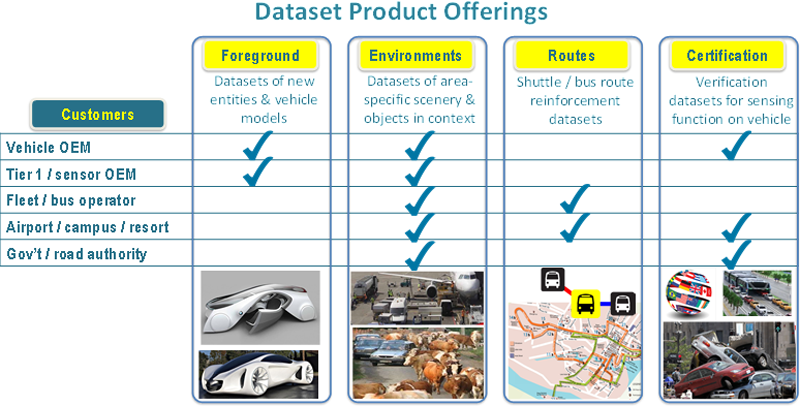
Fig.3. Dataset product portfolio under development at TheWhollySee.
While our technology is still under development and we are not yet in a position to offer datasets, we have a plan for building tailored data packages for different types of customer as shown in Fig.3. For example, we can build targeted foreground datasets to capture new vehicle models that will hit the road in the next couple of years and need to be correctly detected and recognised by other autonomous users.
The second type of data is focused on different backgrounds that represent the environments where autonomous vehicles need to operate. These could be specific settings such as airports and campuses, or broader country-specific backgrounds like local countryside scenes.
Next, we can build reinforcement datasets for autonomous buses and shuttles to increase the recognition accuracy along specific routes. When a bus travels the same route thousands of times over and accumulates the risk in doing so, the AI brain of the bus must make absolutely no mistakes (e.g. missed detections or false positives) all along the route.
Finally, the safety of autonomous agents is predicated on their flawless environment sensing and perception, which require verification and certification using their sensor-specific data. However, the scene diversity and variety of edge cases achievable with physically driveable mileage are insufficient for fully autonomous driving certification. To address this need, we will generate a variety of edge cases and scenarios to test the perception function of autonomous agents. With our data we can count the number of missed detections and false positives to verify and certify the safety of driverless operation.
We are actively seeking both customer feedback and venture funding to build these training and certification datasets that will ultimately guarantee the safety of autonomous driving – and make the Uber incident a non-recurring singularity of the past.

Author: Dr Dan Yanson, CEO, TheWhollySee
With a PhD from the University of Glasgow, UK, Dan has 20 years’ R&D experience in photonics, lasers, and optoelectronics. He planned and managed both technology and product development projects for commercial, defence and space customers in the UK and Israel. He also acts as an external expert for project review and evaluation at the European Commission in Brussels.
TheWhollySee is Dan's first start-up and is a highly multi-disciplinary project combining photonics, artificial intelligence, and autonomous vehicles.
TheWhollySee is a seed-stage start-up developing a human-free image annotation technology to supply terabytes of ground-truth training data for visual perception AI in autonomous driving applications.
It’s the latest tech hype, and it’s coming to mobility: decentralised applications built on blockchain have the potential to profoundly disrupt an industry - transport and mobility - that is already being hit by a “digital tsunami”, as Sampo Hietanen, MaaS Global CEO, often pitches in his conferences.
In cities, consumer habits are more and more shifting from ownership (of a car) to access (to MaaS), enabling new business models and revenue streams, shaping a burgeoning and extremely dynamic mobility ecosystem where traditional players – notably automotive OEMs and public transport operators – are prompted to compete, and sometimes forced to cooperate, with new entrants that have a fresh and creative approach to providing mobility services.
Petrolheads, on the one hand, and public transit fans (or fanatics) that would ban any 4-wheeled moving thing from cities if they could, on the other hand, are witnessing the emergence of a new type of traveller: digitally-savvy early adopters of new mobility services who demand a flexible, seamless, pain-free travel experience, which means the freedom to access the most convenient, comfortable, easy to use, affordable (and, why not, stylish) mode of transport, anytime, at a tap of their smartphone. This takes the expression of services like car-bike-scooter sharing, car-pooling, ride-sharing/hailing, demand responsive transit, and ultimately MaaS, a new paradigm that combines novel forms of urban mobility with public transport (the irreplaceable backbone of urban mobility), blurring the lines between personal and collective transportation.
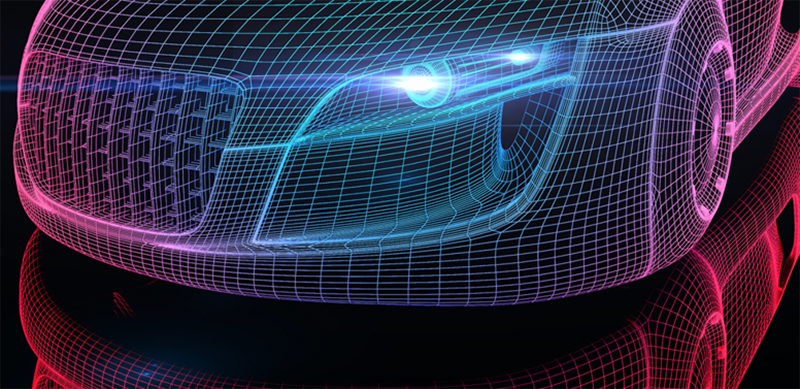
Image Credit: Shutterstock.com
A key enabler for it all is technology, which is the basis for this complex mobility ecosystem to function, where very different stakeholders need to launch transactions between each other (for booking, invoicing, payment, etc.), interact with the traveller, acquire and exchange operational data, and process it into information that is used to fuel and launch related business processes, in a continuous improvement process. It started with “conventional” information and communication technologies - the Internet, in plain words - and it does certainly work well when all participants in the value chain are in the same boat, and have the same understanding of what needs to be delivered.
However, as the participants in the game push the boundaries of what is feasible (and, as an inevitable consequence, the contractual terms between the parties become a hell of endless terms and conditions with countless implications), when having a trusted and secure environment enabling business processes and handling of (personal, business-critical) data is not guaranteed, when interaction with old legacy, locked-in, vendor-specific systems implies non-transparent workflows (to say the least), when some participants hold an abusive control over the provision of (parts of) the (mobility) service, then I tend to think the “old” Internet might not be sufficient to enable MaaS in some cases, or put differently, one needs an additional layer that grants trust (for example for enabling secure digital payments and identity management), adds transparency (while eliminates unnecessary business processes and intermediaries), and eases the contractual side of the service provision.
There is hope: these are foundational attributes of blockchain.
Less is more
MaaS pursues the vision of providing seamless urban mobility services replacing the “need” to own a car. As not yet a single Mobility Service Provider (MSP) can fulfil this service promise, one needs to identify the available supply of transport services and combine them in the most efficient way, so that solving the mobility puzzle in the city – that is, which transport means are available and where, how to book them, how to access them, how to pay for them, how to plan my trips - becomes a piece of cake (from the user perspective, of course, the required processes to run in the background are complex). The challenge is huge for the MaaS operator, with a transportation ecosystem that is extremely fragmented, with stakeholders sadly keeping “their” data “safe” (safe from who, safe from what?) in data silos, with an extremely regulated environment, and new entrants defying the statu quo. Therefore, implementing MaaS requires not only “plain” software connecting legacy systems from MSPs, processing available sets of data, implementing business processes, and interfacing with the user, but the “glue” that puts the pieces together in a meaningful way, making the whole system work in harmony, creating the much needed trust among the participants.
This smart “glue” is a unique combination of well-written, tamper-proof, scalable, standards-compliant software, but also a set of common rules for all stakeholders to comply with, so that no single stakeholder can impose its own rules or prejudices (for example, to artificially favour public transport as the preferential mobility option, hindering fair competition with other mobility options), with the ultimate goal to benefit the end user, in a truly user-centric approach.
Blockchain has the potential to create all these much needed efficiencies that can boost MaaS.
The transportation ecosystem is also crowded, with many stakeholders participating, besides the MSPs (software vendors – too often deploying locked-in or rather proprietary solutions; financial entities – that control the flow of money; insurance companies – that have little idea who is to be made liable under unprecedented scenarios; policy makers, urban planners, etc.). Having so many players adds one more level of complexity, hindering innovation and getting things done. Luckily, blockchain technology offers the intriguing possibility of eliminating unnecessary intermediaries (typical example is financial entities: could we skip them by enabling transparent, secure, commission-free bitcoin transactions for all payments involved in the mobility service provision?).
Blockchain does this by filling three important roles: recording transactions, establishing identity and establishing “smart contracts”.
So we’re heading towards a not so distant future with less intermediaries (well, this is more of a wish than a consolidated trend to skip those stakeholders that add little or no value at all to the effective provision of MaaS...), and definitely less human intervention, with a smarter transport system that is increasingly M2M-connected (some call this “Internet of Mobility”), with technologies such as autonomous driving, wireless EV-charging, electronic toll collection systems, and many more. Needless to say, blockchain is there to provide the required technological backbone supporting this “less is more” paradigm.
Front runners betting heavily on blockchain for mobility
Automakers, big tech firms, nimble startups and banks, notably, are already developing proof of concept applications and investigating how to leverage blockchain technology to solve current and future mobility challenges.
The following four areas are concentrating many of the most interesting current blockchain mobility projects and initiatives:
(Mobility) Data sharing. Data is today’s currency. Many analysts and leaders of the automotive industry predict that data generated by cars will soon be more valuable than the car itself. The challenge is in harnessing that data, monetizing it in a way that the car is no more a depreciating asset, but a steady generator of value.
A related remarkable project is making it to the headlines, lately: DOVU, interestingly a Jaguar-backed blockchain startup, has developed an Ethereum-powered secure marketplace that will let users offset mobility costs in exchange of their transport data. The company will reward users willing to share their data with tokens that could then be used to purchase mobility services, such as public transport. Sign of the times, and certainly a best practice, being upfront and transparent about data use, giving customers both opt-in and incentives for sharing data, instead of simply taking data without even asking.
Eventually, blockchain-powered data exchange platforms could as well handle massive amounts of data pooled from autonomous cars (with lidars, radars, cameras and other sensors constantly streaming data to various blockchains). The development of safe and reliable autonomous vehicles requires a huge amount of driving data, and such a data marketplace could surely help, shortening development and testing times, and bringing autonomous vehicles, and all the expected related benefits of this technology (safety, efficiency, convenience), closer to becoming mainstream. The spectrum of possible applications extends to the whole mobility ecosystem, where city planners and researchers, for instance, could as well use these data to run modelling and simulation for capacity and infrastructure needs.
(Mobility-related) Peer-to-Peer transactions. Privately owned cars are an extremely underused and inefficient asset in cities today, and this has led to the growth of shared mobility services. Although there are certainly many P2P car-sharing schemes available today that empower owners of cars to rent them to other peers when not using them, blockchain-enabled schemes would eliminate or minimize the need for intermediaries (that is, the companies that operate the marketplaces that facilitate this P2P exchange, and thus get a share of the deal). The inherent security and robustness of blockchain will allow individual car owners, but also fleet managers, to lease their vehicles to trusted and identified riders, with the transactions governed by smart contracts crafted on the go reflecting the terms and conditions agreed by the peers, with completely traceable trips recorded in the blockchain, and automatic payments flowing after each trip.
Worth mentioning is Toyota Research Institute, which is partnering with MIT Media Lab and other startups in the blockchain scene, leading the way by developing blockchain apps for car sharing, and extending the focus to multiple other applications, including an open platform for users to control whom to share their driving data with (adding, as an additional example, to the first area of application described in this article), vehicle access and payments, carpooling and Usage-Based Insurance schemes.
Autonomous vehicles. Blockchain can support successful deployment of autonomous vehicle fleets serving different use case scenarios, providing the means for on-demand mobility and effective MaaS development to its full potential (I discuss the autonomous driving factor as a key enabler for MaaS consolidation, mainly from a business model perspective, in my last article).
EY’s Tesseract platform, which is underpinned by blockchain technology, is one of the most ambitious initiatives launched recently in this regard. Blockchain will enable not only shared use, but also shared ownership over fleets of autonomous vehicles deployed in a city. It will facilitate pay-per-use models, and will contribute to optimizing the usage rate of the vehicles, and thus the revenue per vehicle automakers (or any other MSP deploying the fleet) will be able to get. One day vehicles could even be self-owned, running solely on algorithms... Variations are unlimited, or limited only by our imagination.
The opportunity to use blockchain to pool data from autonomous cars has been discussed above in this article. But blockchain can as well be used to provide the means for autonomous vehicles to perform activities inherent to being indeed autonomous, such as driving through tolls, refuelling, (wireless) recharging, parking, and ultimately paying for these services through an integrated blockchain-enabled digital wallet, with a distributed ledger of profit and loss statements available to all involved parties to assess, in real-time, the profitability of that fleet.
Usage-Based Insurance. Allowing vehicles’ sensors to collect driving, telematics data and store them in the blockchain can enable insurance firms to analyse driving behaviour and habits, and therefore offer lower insurance premiums to safe drivers, with a superior level of transparency and security over the whole data sharing process ensured by the blockchain technology. Although Pay-As-You-Go/Pay-As-You-Drive schemes have long been in the market, short-term leasing of cars challenges the “old”, traditional, provision of insurance, where insurance coverage is offered over one year periods of time. Blockchain will allow individual and fleet vehicle owners to lease their vehicles to trusted and identified riders with simple, straightforward smart contracts set on spot, setting the terms of very short rental periods, in a range of minutes (no longer, a middleman clerk sitting at an office desk, asking you long questionnaires, filling in a form with your answers, finally issuing an insurance contract).
Disruption, disruption, disruption
Now, up to this point it seems blockchain has the potential to turn transport and mobility (and virtually every industry) upside down. Nice, but... Are we (consumers, stakeholders) ready to cope with so much disruption? MaaS is a “service promise” that tells users they can live without a (privately owned) car; autonomous vehicles tell users they don’t even need to drive, ...; and now, blockchain tells many stakeholders they’re not needed anymore, or that value provision will follow completely new paths...
As an engineer working in innovative mobility, I tend to think (and wish, and push for, and believe in) every disruptive technology would and should be possible in this space. However, my analytical approach often prevails over my childish aspiration to become a writer (of fiction, I mean, not a technical writer), and so I feel this article deserves some healthy dose of realism to conclude:
With blockchain we’re entering an unchartered territory, and so it’s hard to predict which apps will make it and which ones will fail. It’s going to be exciting times to follow up with first movers’ initiatives that leverage blockchain to develop mobility services that are focused on providing more individualised, customer-centric and efficient mobility services. Blockchain truly has the potential to help MaaS thrive. But real life implementations are still in its infancy, so we will have to take the leap of faith, wait and see... for the next tech hype to come. Hello, blockchain. What’s next?
About the Author:
Josep Laborda thinks mobility outside the box @ RACC Automobile Club and CARNET Barcelona. Mobility not black and white: want both taxi and Uber in my app. He writes fiction, besides technical stuff. Future mobility often sounds like sci-fi, which is great. He loves wine, human towers and photography (not necessarily in that order). More on him: check @josik35 at Twitter and Instagram or his website: http://www.joseplaborda.com. Grown-up, views are his own.
As consumer preferences and expectations change, companies seize the many opportunities mobility offers. From autonomous cars to innovative mobility as a service (MaaS) business models, the innovation & startup scouting company StartUs Insights takes a look at the key drivers behind the digital transformation in the Mobility Innovation Map:
StartUs Insights’ model covers the cutting edge of startup-driven innovation in the mobility industry. This in-depth research is backed by the company’s proprietary data-driven innovation scouting approach in which it analyzed more than 8.000 startups to identify key innovation areas. The Mobility Innovation Map includes eight emerging technologies and the startups driving them.
Connected Car
Through the integration of the Internet of Things (IoT), connected cars are capable of providing valuable services to drivers and relevant information to companies. As connected cars transform into viable sources of data, they enable predictive and preventive maintenance tools (think on-board-diagnostics (OBD)). Taking this concept further, vehicles can be equipped with sensors and electronic control modules, vehicle-to-vehicle (V2V) and vehicle-to-infrastructure (V2I) communications, making them sufficiently aware to avoid accidents or call emergency services in the event of an accident.
Big Data
For mobility companies, big data produces a great amount of data through features like diagnostics, user experience tracking and driver assistance systems – currently estimated to be situated at an impressive 13€ billion. What is more, big data provides the necessary information for the development of emerging technologies and - in collaboration with predictive analytics or machine learning - proves to be effective in planning maintenance and managing transport networks.
Shared Mobility
Shared mobility offers a vast variety of opportunities ranging from car- to bike-, ride- and scooter-sharing among others. Car-sharing alone is expected to be responsible for 4.7€ billion in annual revenues by 2021 with Europe dominating this field. This results in manufacturers changing their mission statements by incorporating new business models or providing mobility services themselves.
Augmented Reality (AR)
Much progress has been made in Augmented Reality in recent years with applications like head-up displays currently being perfected. To date, they are capable of presenting warnings, alerts, and safety aids on invisible screens which are embedded in the vehicle’s windshield. But AR is not limited to ground vehicles alone - as aircrafts strive to achieve greater speed, companies can consider the complete exclusion of windows as a means of attaining sturdier planes, capable of handling such speeds.
Lightweight Materials
Innovative technologies also offer advancements to the manufacturing side of mobility: Trading the steel in a vehicle’s body with a lighter alternative such as carbon fiber or other advanced materials, reduces consumption significantly. While these materials reach the weight requirements, they do not sacrifice safety in exchange. The implementation of lightweight materials is soon to come, while over a medium timespan, 3D Printing (or Additive Manufacturing) is expected to play a key role in improving the process of designing and assembling vehicles, leading to an overall greater performance.
In-Vehicle Services
Though advanced infotainment (or next-gen infotainment) in cars is in not yet used to its full potential, it is estimated that a value of 5€ billion per minute can be created - conditional that all passengers access mobile media content during the average 50 minutes per day spent traveling. This creates an opportunity for broadening the target group for both on-demand media services as e.g. Netflix or Amazon as well as a space for further business model diversification for OEMs and Tier suppliers. Moreover, once autonomous vehicles are the norm, they will be skilled to pick up delivers while on their way to passengers thus further increasing the comfort provided by mobility companies.
Mobility as a Service (MaaS)
MaaS offers consumers the possibility of accessing a variety of vehicles by using the same digital platform rather than just car-sharing or another form of vehicle sharing. This creates the space for multimodal transportation platforms allowing travelers and commuters to optimize their trip by benefiting from different types of transportation. Through exclusively using their smartphone and an app, consumers are empowered to handle all aspects of their journey - from planning to payment.
Autonomous Vehicles
In 2012, the laser sensors used in Google’s autonomous cars cost a staggering 62.000€ while three years later, the price dropped to a mere 6.200€ leading to the overall cost of mass production for autonomous cars becoming much more competitive. Currently, it is still unknown when autonomous cars will enter the mainstream due to the existing technology gap and the regulatory framework. However, we can already see applications in public transportation and on-demand services. In the future, driverless cars will contribute to traffic optimization and passenger safety. Meanwhile, the automotive industry takes a step in between by introducing advanced driver assistance systems (ADAS).
Disruptive Startups In The Automotive Industry Include:
The innovation areas mentioned in the Mobility Innovation Map together with Sensoric, Artificial Intelligence, Virtual Reality, Gamification, and Cyber Security challenge existing structures and transform the entire industry. As demonstrated, startups are in the front seat of emerging innovation areas and disruptive technologies thus collaborating with them is one way for companies to emerge as industry leaders. To conclude, innovation in mobility will benefit the consumer and the environment as well as the automotive industry itself - when executed well.
About StartUs Insights
StartUs Insights is the technology & startup scouting unit of StartUs, Europe’s leading startup & innovation network. Over 300 scouts and more than 40 partner organizations in 60 European cities allow StartUs Insights to cut through the noise and provide corporations with data-driven intelligence on startup driven innovation. Clients include Magna, Borealis, Brisa, Verbund, Accenture, KNAPP and other industry leaders. For more information please visit https://www.startus-insights.com/
By Stephen Smyth, co-founder and CEO of Coord
The transportation industry is arguably undergoing the biggest transition since the advent of the internal combustion engine. This is particularly evident when you look at consumer behavior: a growing group of people is no longer buying cars, they’re buying miles, or perhaps more accurately, arrivals. In 2017 alone, Goldman Sachs reported that 15 million ride-hailing trips were taken per day around the world. By some accounts, this number has already nearly doubled in 2018, principally due to demand in China. Entrepreneurs and investors have been flocking to the sector. According to Crunchbase, nearly six thousand new mobility startups were founded over the past 5 years. The autonomous, electric future is on the horizon. The Boston Consulting Group forecasts that, by 2030, around a quarter of all miles driven in the US will be in shared autonomous electric vehicles. While all of this innovation is exciting, much of the usage is happening in siloed apps. This is at odds with the stated goal of many companies to provide the mass market with a seamless mobility experience. It seems unlikely that any one company can deliver all of the best transport options to every user all of the time within their walled garden. On-the-fly integration of supply across providers is increasingly necessary to deliver on the promise of seamless mobility.
Recently, we’ve seen more and more players in a variety of industries integrate mobility services to differentiate their offering. Starting with Didi in China, ride-hail companies are effectively cannibalizing their short trips by reselling or acquiring bike-share supply. This looks a lot like the online travel agent model of reselling flights, rail and car rentals. As interesting, if less publicized, is the trend of non-transportation companies integrating mobility services into their offering. Witness the bank JPMorgan Chase using Chariot to provide its employees with a more productive commute. Integrating these kinds of shared transportation modes also saves companies the significant expense of providing parking for their workers. In another example, Lyft announced a deal with Allscripts for non-emergency medical transport to help patients get to appointments on time. Essentially healthcare providers are using mobility as a cost of acquisition for a much more valuable service called a medical appointment. And not to be outdone, city agencies are also starting to require integration of mobility services. Last year the city of Seattle shut down its municipal docked bike-share system in favor of multiple competing dockless bike-share operators. As a condition of receiving an operating license, the dockless bike-share operators are required to integrate data about the usage of their fleet into a neutral data exchange administered by the University of Washington. Among other things, this approach enables the city to monitor the number and placement of bicycles in the city and ensure that piles of bikes don’t clog up sidewalks, a common problem in China. A similar approach is likely in other cities facing an influx of shared bikes, scooters and other vehicles.
While some cities and companies are starting to understand the value of integrating mobility services, others have not. Ultimately transportation is a means to an end. It’s about getting a person or a good to a place. Cities and companies that can’t use mobility to make their locations more accessible will fall behind. A recent extreme example of this is the extension of the 7 subway line in New York City to make the massive 10 Hudson Yards real estate development viable. At the other end of the spectrum, local merchants have been offering paper-based parking validation for decades as an incentive for customers to visit their location. Imagine mobility validation as next generation parking validation. Ultimately the shift occurring in the transportation industry will impact not only that industry but all of the economy that depends heavily on the accessibility of location. This shift affects students, patients, workers and even home shoppers and fans of take-out.
The mission of making seamless mobility available to everyone or, put differently, democratizing access to locations depends on several emerging concepts in urban transportation. The first is the idea of trip bundles. We do this every day when we book long distance travel that includes multiple airlines and perhaps also a hotel stay or car rental. In cities, people are starting to hack together trip bundles using multiple modes, payment methods and apps and essentially acting as their own travel agent. There must be a better way. A recent survey by transit ticketing company Masabi suggests that 35% of people take shared mobility options to reach fixed transit at least occasionally. In many cities the most common origin and destinations for bike-share trips are transit stations.
As trip bundles become better supported, the next logical step is to buy the trip from a single point of sale. Why put up with the hassle of buying different trip segments from different providers if you can buy a single trip bundle in one place? Just like the travel industry, it seems likely that consumers and enterprises will use a variety of merchants based on user interface, loyalty programs, prices, packaging, etc. It’s probably not a coincidence that Uber’s (relatively) new CEO and COO previously ran Expedia and Orbitz, respectively.
These merchants and mobility distributors will increasingly use incentives and subsidies to compete. These dollars will likely come from enterprise and public sector transportation budgets that are starting to move online. This future will impact private and public sectors alike. For example, it will enable retailers to digitally incentivize potential customers to attend an annual sale and governments to seamlessly subsidize the trips of senior citizens. Ultimately, these budgets, coupled with the ability to purchase bundled trips online, have the power to make the destinations that people care about more accessible. That, in turn, makes cities more livable.
Stephen Smyth is co-founder and CEO of Coord, the developer platform for the mobility market. The team at Coord is driven by a mission of making seamless mobility available to everyone. Coord is accelerating this outcome by empowering any software developer to integrate transport options for drivers and riders into smartphone apps, autonomous vehicles and every technology stack in between.
Derek Bryan, Vice President EMEA, Telogis
Autonomous vehicles will represent approximately 25% of passenger vehicles by 2030, and in the UK, trials have already been announced for convoys of partially self-driving lorries. Although advanced infrastructure, legislation and consumer trust will take time to evolve, it’s clear that any fleet-owning business will be affected by self-driving vehicles eventually. So what can they do now to prepare themselves for this autonomous future?
Investing in connected ecosystems
Automation is measured in five stages; the fifth and most advanced stage refers to a fully autonomous system where the vehicle’s performance is equal to that of a human driver. At the moment, we’re at stage two, which means that some driver assistance systems can be automated, such as cruise control and lane-centring. It’s not until stage five that we will be witnessing the widespread adoption of completely driverless vehicles.
In the interim, companies shouldn’t wait until their next vehicle purchase can be a fully autonomous. Instead, they should begin investing in the connected vehicle ecosystem and upgrading their fleets to ensure they’re up to date with the latest technologies. Connected vehicle technologies offer a wide range of benefits that can boost safety, productivity and efficiency across mobile operations. This expanded connectivity increasingly removes guesswork from operations, giving businesses advanced insight into every detail.
Recent innovations
In recent years, there have been many major advancements in connected vehicle technologies, such as video-based safety and compliance systems, AI-powered predictive maintenance, and real-time GPS-enabled parking. Companies can monitor driver behaviour or safety tracking and can even use data to coach drivers on their performance in near real time. In doing so, fleet managers can quickly stamp out any inefficiencies such as idling, as well as improve the overall safety of their employees.
Those in more advanced stages of connectivity are trialling innovative technologies such as truck platooning. This is where small convoys of lorries are digitally tethered together, this enables them to travel more closely together, reducing fuel consumption and congestion.
Challenges for the future
It is estimated that over the next three years, at least one in five vehicles will have some form of wireless network connectivity. However, the growth in connected and autonomous vehicles is not without its challenges. Take the data demands of a driverless car, for example. Typically, an average consumer will burn through several GB of data every month on their smartphone. It’s estimated that a fully autonomous vehicle would require up to 4TB (4,000 GB) of data every single day. Further, a recent study estimated that a battery powered haulage truck would guzzle up the energy needed to power a whopping 4,000 homes in order to fully recharge itself.
Clearly, our current infrastructure is inadequate to support the needs of an autonomous future. Widespread adoption of a connected vehicle infrastructure will require networks capable of the lightning-fast speeds to sustain it. For this to become a reality, building and maintaining a robust 5G infrastructure to handle these demands must be a priority.
Fortunately, significant investments are already being made in this area. They are collectively known by the acronym CASE: Connectivity, Autonomous Driving, Sharing, and Electrification. Over time, as the algorithms used by autonomous vehicles are improved, the amount of data needed can be expected to significantly reduce.
The fully autonomous future is still a number of years away. However, businesses of all sizes have the opportunity to plan ahead by investing in the connected vehicle ecosystem. This will have an immediate and transformation effect on their business, and in the long term, will ensure they are fully prepared. While many aspects of our autonomous future are yet to be determined, beginning strategic investments in the short term will help businesses ready themselves for new developments.
When building autonomous vehicles, one of the most important challenges is ensuring that the vehicle can see the world around it. To help solve this problem, Innoviz Technologies and its partner, Magna, have been selected by the BMW Group to provide solid-state LiDAR for upcoming series production of its autonomous vehicle platforms. This groundbreaking, high-resolution LiDAR technology generates a real-time 3D point cloud of the vehicle's surroundings, even in challenging settings such as direct sunlight, varying weather conditions and multi-LiDAR environments, in order to help facilitate levels 3 through 5 of autonomous driving. In addition, the solution provides a complete computer vision software stack and algorithms to turn 3D vision into critical driving insights.
LiDAR (Light and Detection Ranging) is recognized as an essential technology for developing autonomous vehicles because it enables 3D object detection and scanning performance that cameras and radar sensors cannot match. Yet in order for LiDAR to become commercially viable, it must be delivered within a solution that ensures performance, safety, reliability, cost and size, for the mass market. Currently no solution on the market meets all of these requirements, but Innoviz, owing to a major technological breakthrough, has developed a LiDAR that meets all of the automotive industry's requirements and delivers a solution to drive the industry forward towards full autonomy.
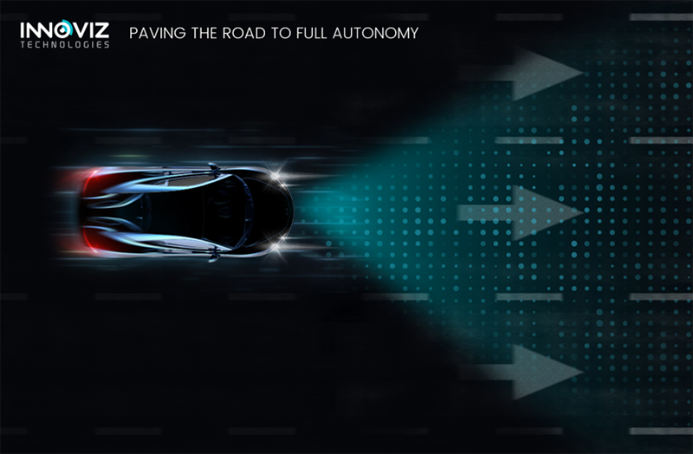
Innoviz identified a major gap in the market and came up with a disruptive technology design that delivers a comprehensive mass-market solution to enable the mass commercialization of autonomous vehicles. In order to fix the design and performance flaws of existing LiDAR solutions, the company had to redesign most of the components in the system and invent a new solution from the ground up.
InnovizPro, the company’s stand-alone LiDAR solution, launched at this year’s CES conference and is currently available for purchase directly from Innoviz, enables OEM’s, robo-taxi fleets, Tier 1’s, and other automotive companies immediate accessibility to the company’s groundbreaking technology. These stakeholders can integrate it into the next generation of their autonomous vehicles for testing and development. Moreover, the current availability of InnovizPro opens the door for Innoviz to tap into additional markets, including industrial automation, security and surveillance, logistics and others. While InnovizPro devices can be ordered now to support testing and development of autonomous vehicles, Innoviz continues to improve upon its industry-leading scanning performance with the introduction of InnovizOne™, a built-in, automotive-grade LiDAR that will feature even higher standards of performance, reliability, size and affordability when samples become available in 2019.
InnovizOne’s exceptionally high frame rate, combined with its high angular resolution and wide field of view, enables it to create an extremely dense 3D point cloud offering optimal clarity and accuracy, even at long distances.
In addition, Innoviz will provide BMW with a complete computer vision software stack that leverages deep learning and a critical algorithmic layer to turn 3D vision into critical driving insights. This software layer uses the company’s advanced LiDAR information to provide object detection and classification of pedestrians, cars, trucks, bikes, driveable area, lane marking etc.
BMW is setting a high standard in autonomous vehicles development, and their vote of confidence in Innoviz’s LiDAR demonstrates how advanced the technology is. The Innoviz and Magna teams collaborated to meet BMW’s requirements in quality and functional safety.
Jaguar Land Rover deploys their data analysis files from a local data centre to Google Cloud Storage without losing compatibility with DataFinder by using the SME Native Drive.
Jaguar Land Rover has deployed Storage Made Easy’s Cloud Drive in the Google Cloud, allowing critical file system-oriented applications to access data stored securely on Google Object Storage.
Jaguar Land Rover (JLR) uses National Instrument’s DataFinder to index and analyse over a terabyte of time-series data created each day. The data is generated from test drive sensors and measurements, and adhoc measurements from 400 dataloggers in the powertrain calibration and controls department. It is then and saved directly on Google Cloud Storage. The challenge has been how to take advantage of the cloud for increased durability and agility when the application can only index and manage data from file-based storage systems.
The Storage Made Easy Google Storage Drive allows applications, and end users, to connect to Google Cloud Storage as if it was a local read-write hierarchical file system. The drive allows Jaguar Land Rover to move their data management and analytics platform to Google Cloud with minimal migration costs.
The Cloud Drive is optimised for large data sets and deep folder hierarchies and does not obfuscate object metadata, allowing concurrent access by apps directly to Google Cloud Storage.
Maxime Lecuona, Power Train Calibration and Controls Data Processing team leader at Jaguar Land Rover, said: “Moving our infrastructure to Google cloud is a critical project for us. We are planning on leveraging this new platform to gain in flexibility and ultimately provide our services to a wider portion of the company. Storage Made Easy Google storage drive is allowing us to transfer our current infrastructure to this new environment with minimal change to the existing code, and at a very reasonable price.”
Jim Liddle, Storage Made Easy CEO, said: “Cloud technology is undoubtedly a great way for companies to free up IT to concentrate on innovation, but there is still a need to bridge the gap between remote cloud storage and critical business applications, and this is what the Storage Made Easy solutions provide.”
Transportation-as-a-Service (TaaS) Technology Conference is a two-day global conference and exhibition dedicated to covering the key topics of the Connected & Autonomous Vehicles (CAV) and Future Mobility industry and it will take place on July 9th and 10th 2018, The Slate, Coventry, UK. The TaaS Technology Conference will bring together international experts for two days of in-depth discussions and exhibits focused on the opportunities and challenges of a mobility future that leverages CAV and TaaS technologies.
Attendees to the conference will hear industry-leading insiders delivering more than 40 presentations spanning eleven key topics. The conference will equip the delegates with an up-to-date overview of the status of the CAV and TaaS industry, and provide them with many opportunities to meet other key players within this community.
The event is being organised in partnership with Coventry City Council, Coventry University and WMG, at the University of Warwick and has attracted an array of leading international experts.
Speakers include: Autosar, AXA Insurance, ARUP, Coventry University, European Investment Bank, Ford Motor Company, HMI Technologies, IBM, IHS Markit, In Motion, Jaguar Land Rover, Local Motors, KPMG, MaaS Global, MaaS Alliance, Microsoft, Nokia, NVIDIA, Orange, Pinsent Masons, Ridecell, SAP, SBD Automotive, SAP, TRL, Thales, TomTom, UBER and Vision Mobility.
With only a maximum of 250 delegate places and 20 exhibitors, the conference is almost sold out. With less than 4 weeks to book your place, less than 30 delegate spaces left and only 2 slots in the exhibition - book today to make sure you are at the must-attend CAV and Future Mobility conference of 2018!
The 2 day conference and exhibition will look at all the key topics surrounding connected and autonomous vehicle technology and how this fits into a new future for mobility. The event is being organised in partnership with Coventry City Council, Coventry University and WMG, at the University of Warwick and has attracted an array of leading international experts.
Transportation-as-a-Service (TaaS) Technology conference and exhibition will focus on Connected and Autonomous Vehicles (CAV) and the future of mobility. The conference will take place 9-10 July 2018 at The Slate, University of Warwick, Coventry, UK. www.taas.technology
The autonomous vehicle era is here. According to industry estimates, the autonomous vehicle market will be worth US $87 billion by 2020, and by 2040, it is predicted that up to 40 percent of new vehicles will be autonomous.
The TaaS Technology Conference will bring together international experts for two days of in-depth discussions and exhibits focused on the opportunities and challenges of a mobility future that leverages CAV and TaaS technologies.
The conference is supported by and organised in partnership with Coventry City Council, Coventry University and WMG, at the University of Warwick. All 3 partners are heavily involved in the research and development of CAVs and are part of a number of leading projects which are helping to shape the future of mobility.
Industry insiders including major international auto makers believe autonomous vehicles will open new opportunities and create an impetus for innovation within organisations across the existing automotive, digital and transportation supply chains. Alongside this, new entrants are leveraging advanced technologies and manufacturing processes to create new opportunities in TaaS and with CAVs.
Aimed at the international CAV, TaaS and future mobility community, the conference will cover 11 key topics:
Confirmed speakers at the conference include the below plus many more. The full list can be seen here.
The full list of speakers can be seen here: taas.technology/speakers
“The future of mobility and CAVs are a hot topic right now. Transportation as we know it is ripe for disruption. With traditional car manufacturers, OEMs, software companies, component providers and new transportation companies investing billions of pounds into the research and development of CAVs and future mobility systems, we feel the time is right to launch the TaaS Technology conference to connect, inform and inspire the CAV and TaaS Industry,” said Sukhi Bhadal, Event Director, TaaS Technology Conference.
“The two-day conference and exhibition will be a unique event allowing for education, influence and networking between the major international players who are driving forward the new mobility revolution, a revolution which has the potential to save lives and bring new mobility solutions to millions of people.” added Bhadal.
Cllr Jim O'Boyle, cabinet member for jobs and regeneration in Coventry said, "I'm really pleased that Angel Business Communications has decided to hold their Technology Conference here in Coventry. We have a rich tradition in the automotive sector and we are shaping up to have an equally fine future too.
"In the near future, this sector which includes battery development and autonomous and connected vehicles alongside other solutions like very light rail is set to generate thousands of new jobs and I believe Coventry will be a the very centre of things.
"Hosting an event here which will bring together leaders in this rapidly developing field is very good news indeed." added O’Boyle.
Professor Andrew Parkes, executive director of Coventry University’s Centre for Transport and Mobility, said: “We’re thrilled to be part of an event which is positioning Coventry as a city that’s front and centre when it comes to research and development in the field of transport and future mobility, which is where it belongs.
“For our part, we look forward to engaging with colleagues and collaborators in the industry to offer insight and expertise to help shape future activities around areas such as autonomous vehicle technology, transport design and optimisation of low carbon powertrains.”
“We fully support bringing people together from the relevant industries to collaborate on complex CAV issues. It will involve a multitude of emerging technologies, human factors and legislation to consider and this conference will be an ideal platform to connect, inform and inspire the CAV and future mobility industry.” said Paul Jennings, Professor, WMG, University of Warwick.
“The three hot topics in ITS and mobility are Connected Automated Vehicles and Driving, Mobility as a Service and the sharing economy and air quality. If we get the implementation of CAV and TaaS right we will also address the air quality issues. Integration is key and this timely conference will provide an ideal opportunity for experts to discuss these issues and to inform decision makers” commented Richard Harris, Director at HMI Technologies and a member of the conference program board.
“One of the key reasons for my involvement is that I believe that Mobility / Transportation as a Service will become the next great platform that will drive new business ideas, just as the internet and the smartphone have done in the recent past. The TaaS Technology conference promises to be an exciting event as it will give participants an early window into the future, and a substantial leg up to seek out new opportunities. The speakers are industry leading experts and there will be a wealth of knowledge and information available for attendees.” added James Carter, Principal Consultant at Vision Mobility and a member of the conference program board
TaaS Technology Conference will take place on the 9th and 10th July 2018 at The Slate Conference Centre, Warwick University, Coventry, UK.
For further information on speaking, sponsorship and exhibition opportunities please contact:
Sukhi Bhadal, Event Director.
T: +44 (0)2476 718970
There are less than 4 weeks left to book your place and less than 30 places left. Book Today! www.taas.technology

Getting around in crowded city streets of America is about to get a little easier. May Mobility, an Ann Arbor, Michigan startup building self-driving shuttles, has partnered with Magna, a mobility technology company and one of the world’s largest automotive suppliers, to retrofit and scale up May Mobility’s unique fleet of self-driving shuttles set to enter the US market.
This partnership is an industry-first, with Magna retrofitting low-speed self-driving micro transit electric vehicles from the chassis up. The initial fleet of vehicles will debut on June 26, 2018 with May Mobility’s first commercial deployment which will take place in Detroit, Michigan.
“Magna is pleased to work with a company like May Mobility to help support new mobility in city centers," said Swamy Kotagiri, Magna Chief Technology Officer. “This project demonstrates our complete vehicle and technical expertise which supports both existing automakers and new companies entering the automotive space."
Magna will work on the vehicles in its Troy, Michigan-based custom build center, with May Mobility engineers collaborating on the development from its Ann Arbor headquarters. Starting with existing stock vehicles, the new partnership will create a number of street-ready self-driving electric shuttles designed by May Mobility and assembled by Magna that can scale in volume to hundreds, and eventually thousands of shuttles as market demands increase. Inside the Magna facility, its team of experts is doing a full rebuild for May Mobility’s self-driving shuttle, including:
May Mobility will continue to further retrofit the vehicles with its proprietary technology stack, bringing safer and more reliable self-driving vehicles to complex urban and residential environments.
“Magna shares our high technical standards and excitement about servicing the growing demand for self-driving vehicles to meet today’s transportation needs, while also laying the path for the future," said Steve Vozar, founder and CTO for May Mobility. “This deal demonstrates our commitment to scale and accelerate operations with a partner who understands quality and reliability in the build process, and who can match the exacting process that makes us a trusted community partner."
May Mobility’s distinct approach – partnering with developers, urban planners and municipalities to understand their needs and design solutions – establishes May Mobility as the trusted autonomous vehicle partner, both in communities and across the industry. The company intends to offer on-demand services by 2019 and expand its suite of vehicles and services based on customer demand.

At the CES Asia 2018, BMW China and Baidu announced the signing of an agreement between BMW Connected and Baidu Internet of Vehicles on a home-to-vehicle cooperation. This will further expand the application of BMW Connected, from vehicles and mobile devices into the digital lives of customers.
This service enables customers to access vehicle information by voice control and operate relevant functions easily from their home. For example, they can check fuel levels, lock their car doors via remote control, search for mobility information stored by BMW Connected and plan routes and departure times in advance. The voice control function can be activated simply using certain wake-up words.
The cooperation between BMW Connected and Baidu Internet of Vehicles provides further evidence of BMW’s “In China, for China" R&D strategy. BMW has been actively building and integrating China’s digital ecosystem, expanding the implementation of its open innovation cooperation with leading Chinese high-tech companies, and is committed to creating a diversified and smart mobility experience for Chinese consumers.
BMW Connected seamlessly integrates vehicles into their users’ digital lives via multiple touchpoints, such as the iPhone and Apple Watch. It is powered by the BMW Open Mobility Cloud, a highly flexible, cloud-based system. With BMW Connected, mobility extends beyond the vehicle. BMW is committed to building a comprehensive mobility ecosystem and providing intelligent, seamless and personalised mobility services for customers.
BMW Connected was launched in China in December 2016 and now has over one million customers and counting. In addition to global services, BMW Connected also offers a range of services tailored to Chinese customers, such as making appointments for vehicle repairs and maintenance, an airport premium service, valet parking, fuel card recharging, a traffic violation query service and a payment service. BMW Connected is available on both iOS and Android platforms. The software upgrade allows BMW Connected to keep expanding its range of services to develop the local digital ecosystem and promote premium services for Chinese customers.
Together with automated driving, the ongoing expansion of connectivity as we approach a digital and emission-free future is one of the central spheres of activity in which the BMW Group is driving forward the transformation of the mobility sector as part of its NUMBER ONE > NEXT strategy.

TomTom announced that it has teamed up with ParkWhiz to provide TomTom with access to the databases of dedicated public parking facilities for the United States and Canada.
By integrating the parking information with its highly detailed and accurate maps, TomTom enables end users of its location products to quickly find and navigate to parking destinations.
TomTom will also provide reservation capability, allowing drivers to view, reserve, and pay for parking from the comfort of their vehicle. This will facilitate an end-to-end parking service, equipping drivers with the service needed to finalise their parking experience.
“With parking information cited as a top connected service being integrated by automakers, TomTom is committed to delivering a service that offers location precision and reliability," said Antoine Saucier, Managing Director, TomTom Automotive. “We anticipate that by providing highly relevant parking information to drivers, we will be able to deliver some of the same benefits that users of TomTom Traffic have experienced over the last 10 years: saving time and money, reducing stress, and minimising environmental impact."
“As autonomous vehicles become the norm instead of the exception, we’re thrilled to bring parking solutions to TomTom’s customers, and to be a part of their vision for the future of transportation. This aligns perfectly with how we see parking solutions fitting into the space, a layer that benefits the driver and is a part of their existing experience," said Dan Cummings, VP Platform Solutions and Strategy, ParkWhiz.
TomTom’s parking product portfolio, encompassing both on-street and off-street content, is designed to enable smart parking solutions and empower drivers during their parking search. These products are available to TomTom’s Automotive and Enterprise customers in a variety of delivery formats.

Fisker ‘s Orbit, the world’s most appealing autonomous electric shuttle, will feature Protean Electric’s revolutionary in-wheel eDrive technology – allowing the visually stimulating vehicle to maximize interior space while further redefining the future of short trip mobility.
Created by Fisker – designer and manufacturer of the most desirable electric vehicles complemented with breakthrough automotive technology – the Orbit significantly enhances the passenger experience in urban environments, including smart city ecosystems.
As a sample scenario, people will no longer have to wait at a bus stop, as Orbit shuttles will be fully connected – with their locations available to be viewed on a mobile application for set routes.
Its stylishly ergonomic interior will offer a variation of mood zones, depending on the passenger’s preference – and the shuttle will offer new digital experiences to further enhance rides. Orbit’s exterior reflects Henrik Fisker’s futuristic design vision for smart mobility.
Protean’s groundbreaking ProteanDrive is an in-wheel eDrive system selected by Fisker engineers to help optimize interior space and simplify powertrain integration. With the vehicle not featuring a steering wheel or pedals, the configuration enables the Orbit to comfortably carry passengers without the intrusion of traditional powertrain components.
Henrik Fisker, chairman and CEO of Fisker, commented: “The Fisker Orbit already encompasses breakthrough automotive technology, design innovation and exciting touches that will change the way urban populations think about short trip experiences. We selected Protean’s in-wheel powertrain technology to further deliver on those promises. The fastest path to fully autonomous vehicles – without a steering wheel – is through shuttles like the Orbit, and we’re excited to lead the charge into the future of mobility with such world-class, sustainable technology."
KY Chan, CEO of Protean Electric, added: “Fisker aims to set a new standard of excellence and performance in the electric vehicle industry and mobility services. We are delighted to be partnering with their team to further solidify that standard. Our technology provides a digitally smart, stand-alone eDrive solution with packaging advantages, new vehicle design opportunities, performance benefits and cost savings."
The Fisker Orbit will be available in either two-wheel or four-wheel drive configurations – depending on customer needs. The company will begin testing prototypes of the vehicle – with integrated Protean powertrains – this year, while full deployments of the Orbit on a set route are scheduled for next year.
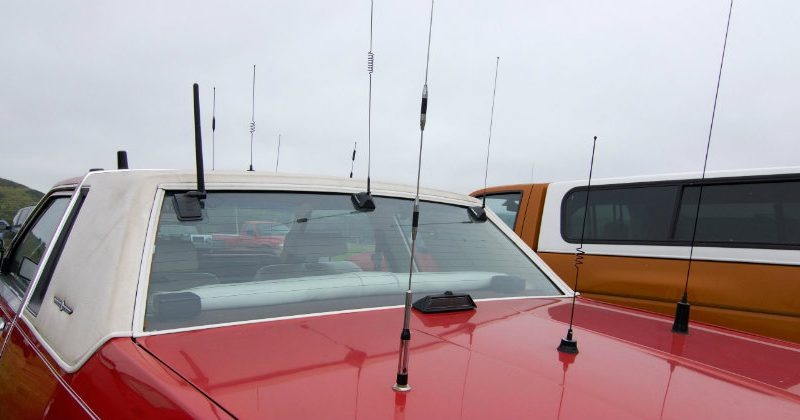
With predictions that the modern connected car could need as many as 18 antennae to provide all relevant services, Harman announced a 5G-ready, multiband conformal antenna for cars, which combines multiple antennae in one module that can be mounted below a vehicle’s body panels, allowing car makers new possibilities for vehicle design.
“Up until now, car makers have typically employed a “shark fin" antenna in combination with a variety of other antennas distributed around the vehicle but with ever more connected services, it’s no longer viable for designers," said Vishnu Sundaram, Vice President, Telematics Business Unit, Harman Connected Car. “Working with Samsung and several OEM partners, the Harman team has designed a solution that is compact and aesthetically pleasing."
Alongside the current WiFi, Bluetooth and radio connectivity, Harman’s antenna can also accommodate Vehicle to Infrastructure, Electronic Toll Collection and Remote Keyless Entry. 5G connectivity brought by this antenna will allow drivers and passengers to completely change the way they go about their drive, allowing them to stream content at unprecedented speed to truly personalise their experience.
“We’re currently evaluating the antennas with several premium car makers to validate the design for each specific vehicle and expect to see the conformal antennas available for model year 2021 vehicles," added Sundaram.
According to BI Intelligence, by 2020 there will be around 220 million connected cars on roads across the globe, increasing from the 30 million connected cars in use today.
UK’s Business Minister Richard Harrington invited companies to bid for £30 million of funding to support the development of self-driving vehicles on UK roads.
Funded through the Centre for Connected and Autonomous Vehicles (CCAV) and Meridian, the Government’s unique hub for testing autonomous technology, the competitions see Government and industry jointly investing in UK businesses to help realise the Government’s ambition to see fully self-driving vehicles on UK roads by 2021.
The next round of the competition could answer drivers’ parking woes since up to £5m will be awarded to projects developing and testing autonomous parking technology. This technology will allow self-driving cars to park in a range of different environments without human intervention.
The money will also fund two public-testing sites for self-driving cars in urban settings, the first of the kind in Europe, these sites will ensure that connected and autonomous vehicles to become a normal feature on UK roads. It is part of the modern Industrial Strategy’s Mobility Grand Challenge to invest in and shape the design, development and manufacture of the transport system of tomorrow.
Business Minister Richard Harrington said: “Self-driving vehicles have the potential to revolutionise the way we move people and goods across the UK. They also support our ambition for a cleaner, greener future as part of our modern Industrial Strategy. The UK is already leading the way in developing this technology and today’s funding will bring self-driving vehicles one step closer to becoming a normal feature on UK roads and could, in time, make learning to parallel park a thing of the past."
Chair Automotive Council Technology, Graham Hoare said: “On behalf of the Automotive Council, I welcome the latest developments at Meridian Mobility Technology, the UK’s CAV Development Capability. Meridian continues the acceleration of the UKs CAV development facilities with the announcement of important partnerships as part of the latest outcomes of the TestBed program, Wave 2&3. These new capabilities will complement our strengthening UK Test capability with the advantage of a ‘one stop shop’ mind-set for the industry."
The Mayor of London, Sadiq Khan, launched a new taskforce dedicated to boosting the infrastructure needed to increase the take-up of electric vehicles across the capital.
He will also encourage the boroughs, Government and all those involved in the taskforce to work together and redouble efforts to install vital rapid charging points and help tackle London’s air pollution.
Encouraging more Londoners to make the switch from diesel to electric cars is vital to tackling the city’s air pollution and realising the Mayor’s ambition of becoming a zero-emission city.
London is already leading the way in this field, with the rollout of electric buses, electric taxis and the installation of 104 rapid charging points under Sadiq’s watch, more than half of which are for taxis and can charge a vehicle in just 30 minutes instead of the standard eight hours. London is a leader in this field, with more rapid charging points installed across the capital than many other global cities, including New York Stockholm and Madrid.
This new rapid network has mostly been delivered on land or roads managed by TfL – a limited resource. The capital requires a major expansion in charging infrastructure to help businesses, taxi drivers and Londoners switch to electric, and the Mayor believes this must be delivered in partnership with the private sector.
Mayor brought together representatives from business, energy, infrastructure, government and London boroughs at a special event to mark the launch of the taskforce, which comprises16 organisations including UK Power Networks, the British Retail Consortium and the RAC Foundation. The work of the taskforce will also be outlined, including technical workshops run by Transport for London over the summer and a shared Delivery Plan to be published next year.
Sadiq Khan, Mayor of London, said: “I’m delighted to launch a new Electric Vehicle Infrastructure Taskforce today, bringing together industry, businesses and the public sector to work together to deliver electric vehicle charging infrastructure in the capital. London’s filthy air is a public health crisis, and encouraging more Londoners to switch from diesel to electric vehicles is critical in tackling it."
“We’ve received huge support for this new taskforce, showing it is not just an environment or transport issue but one that is vital to the future of our city, and organisations across all sectors are stepping up and accepting they have a part to play. This initiative will support London boroughs and ensure electric vehicle infrastructure is installed in the right places, and help make our city an even better place to live."
Around 2,000 standard charge points are already installed across London, at least 150 TfL-funded rapid charge points are set to be in place by the end of 2018 in addition to new infrastructure in residential neighbourhoods. The Mayor would also like to see rapid charging ‘hubs’ – a group of charging points, similar to petrol stations, set up across the city.
A £42 million fund is also already available to encourage the owners of the oldest, most-polluting diesel black cabs to retire them from the capital’s fleet. The owners of black cabs between 10 and 15 years old can apply for a grant of up to £5,000 in exchange for retiring their taxi, and cab drivers can also get up to £7,500 towards the purchase of a new vehicle.
Building upon Ford’s long-standing commitment to commercial and government fleets, as well as the company’s commitment to deliver 100% connectivity across its vehicle lineup, Ford Commercial Solutions is introducing two products designed to help fleets easily access useful data about their vehicles.
Ford has sold America’s best-selling line of commercial vehicles for 33 straight years. The creation of Ford Commercial Solutions builds on that leadership by helping fleet operators make the most of increased automotive connectivity.
“Business owners and operators want to serve their customers, not spend excessive time managing their fleets," said Lee Jelenic, CEO, Ford Commercial Solutions. “Our goal is to unlock the data from their vehicles to provide them with more effective ways to manage their fleets and improve operations. Our new products are tailored to serve fleets of all types, whether they’re run by law enforcement, composed predominantly of Ford vehicles, or are large multi-make fleets that want more insight from their Ford vehicles."
The Data Services product focuses primarily on serving large company fleets, telematics service providers and fleet management companies. The service takes advantage of Ford vehicles’ built-in modem to transfer vehicle data directly from the vehicle to the cloud, without the need for additional third-party hardware, management or installation downtime, as is required for a third-party plug-in device. The vehicle data is relayed to a fleet’s internal IT system or telematics service provider through an application program interface.
Utilising Data Services, fleets can gain access to Ford vehicle information such as GPS location, mileage, fuel use data, vehicle health alerts, driver behavior and more. Because Ford designed the vehicle, including its electrical architecture, data systems and vehicle technology, the company is able to provide the newest updates and vehicle signals as soon as they become available, and deliver insights as quickly as businesses need them.
Additionally, Ford Commercial Solutions is committed to ensuring fleets have the power to choose which telematics service provider or fleet management company is the best fit for their business. While continuing its existing relationship with Verizon Connect, Ford Commercial Solutions has secured new service agreements with Geotab and Spireon to ensure fleet operators have choice in telematics service providers.
“Fleets told us they want to be able to choose how to best manage their fleets," said Jelenic. “Our agreements with different service providers, coupled with the new products we are introducing, allow us to offer this."
Ford Commercial Solutions’ second product is a new fleet information tool designed to support law enforcement fleets. The tool uses information collected through the Data Services product and distills it to provide police fleets with insights that can help improve fleet efficiency and driver behavior. The application translates information flowing from their Ford vehicles into insights on fuel usage, carbon dioxide emissions, vehicle health and driver seatbelt usage.
That data is shared through an intuitive website that provides law enforcement operators with an easy way to check how their fleet, or a particular vehicle, is operating.
Fleets with Ford vehicles that are not equipped with modems will be able to take advantage of both Ford Commercial Solutions products later this year, when a Ford-engineered plug-in device will enable fleets to connect Ford vehicles dating back to the 2012 model year.
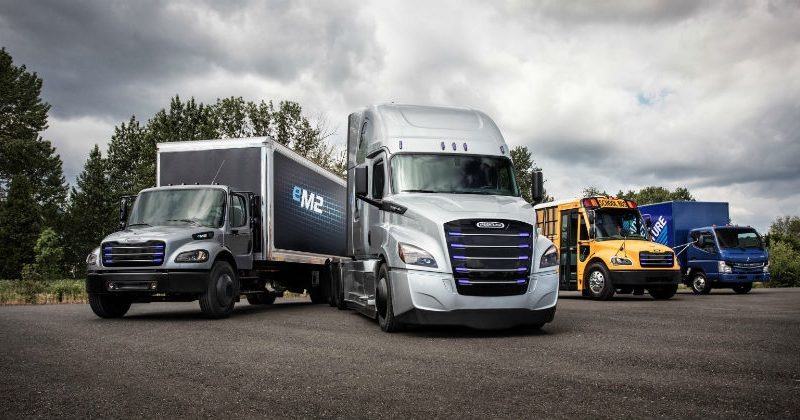
Daimler Trucks is establishing a global organization for e-mobility, including a new leadership function.
Daimler Trucks is establishing a global organization for e-mobility, including a new leadership function. During the Capital Market & Technology Days in the US, Daimler Trucks also presented two new, fully-electric trucks from Freightliner, its leading US truck brand. The world’s largest commercial vehicle manufacturer presented the new Freightliner eCascadia, a heavy-duty electric truck for long-distance operations (>15 t GVW) in Portland (Oregon). A fully-electric variant of the Freightliner eM2 106 covers the medium segment (9 to 12 t GVW). Daimler Trucks North America (DTNA) is planning to hand over an innovation fleet of around 30 electric trucks to its first customers in the US in the course of this year. As is already the case with the fully-electric FUSO eCanter light truck and the medium Mercedes-Benz eActros, it is the company’s objective to gain experience in eTrucks by working together with customers to establish how electric trucks can be efficiently deployed in day-to-day transport operations.
With the two e-trucks from Freightliner, the Mercedes-Benz eActros, the FUSO eCanter, the fully-electric Mercedes-Benz Citaro city bus and the Thomas Built Saf-T Liner C2 Jouley school bus, Daimler Trucks & Buses already has one of the broadest portfolios of fully-electric commercial vehicles.
Martin Daum, member of the Daimler Board of Management for Trucks and Buses, stated: “We are the undisputed global leader of the trucking industry and we intend to remain in that position with electric trucks and buses. We were first-movers on electric trucks and strive to set the standard in each relevant segment. With the formation of our new global E-Mobility Group, we will maximize the impact of our investments in this key strategic technology. Thus, we can pursue the best solutions in batteries, charging solutions and energy management."
The new E-Mobility Group unit will consolidate the worldwide know-how of Daimler Trucks for electric drive systems
Daimler Trucks & Buses sees electric mobility as an innovation driver in the commercial vehicle industry and as a decisive factor for leading the transport sector into an emission-free future. In doing so, the following objective applies: e-mobility must be cost-effective – both for the customer and for the manufacturer.
Moving forward, the E-Mobility Group (EMG) will — across all brands and divisions — define the strategy for electric components, complete electric vehicles, and develop a standardized, global electric architecture similar to Daimler Truck’s global platform strategy for conventional engines and drive components. EMG is set up globally with employees working in various locations throughout the company’s worldwide development network, i.e. in Portland (US), Stuttgart (Germany) and Kawasaki (Japan). Effective July 1st, Gesa Reimelt, who is currently head of Product Projects Powertrain & eDrive Mercedes-Benz passenger cars, will become head of this new, globally engaged and cross-divisional organization. In this function she will report to Dr. Frank Reintjes, head of Global Powertrain and Manufacturing Engineering at Daimler Trucks.
“We expect increasing demand for electric trucks and buses, and are also receiving these signals from our customers. Only manufacturers who lead the field in both conventional drive systems and electric drive systems are able to offer convincing solutions, technically and business-wise. With regard to conventional powertrains, we have always benefited from our worldwide platform strategy. We will also be taking this approach for electric drive systems in the future. To this end, we are establishing the E-Mobility Group in which our experts from all functions around the world will work together on the best e-systems", said Frank Reintjes, member of the Divisional Board of Management, Daimler Trucks & Buses responsible for Global Powertrain and Manufacturing Engineering.
Freightliner eCascadia and eM2 for the NAFTA region
The Freightliner eCascadia is based on the Cascadia, the most successful heavy-duty long-distance truck (class 8) in the North American market. 730 hp is almost silently generated under the characteristically long, US-style hood. At 550 kWh, its batteries provide enough energy for a range of up to 400 km (250 miles), and can be recharged to around 80 percent within 90 minutes to cover a further 320 km (200 miles).
The Freightliner eM2 106 is intended for local distribution operations and last-mile delivery services. The batteries of the new electric version provide 325 KWh for up to 480 hp. The range of the eM2 is around 370 km (230 miles). The batteries can be recharged to around 80 percent within 60 minutes, sufficient for a range of around 300 km (184 miles).
Frank Reintjes added, “With our trucks and buses we want to make our customers more succesful. This applies to both electric trucks and conventional powertrains. Hence, we designed the Freightliner eCascadia and the eM2 here in the US, according to the specific requirements of our customers. As the undisputed market leader in North America, we know that only trucks and buses that fully meet the needs of transport operators will prevail in the market."
Before the end of this year, a total of around 30 units of these models will go to the first customers in North America. With this innovation fleet, DTNA is working with transport companies in day-to-day operations to find out more about transport assignments for emission-free trucks, in order to respond to customer needs even better in the further development of electric drive systems.
It will firmly establish the UK’s presence in the connected and autonomous vehicle market, and contribute to the UK’s Industrial Strategy.
The specially selected networked roads cover a range of representative areas and will be the largest, most diverse testing environment in the UK, with the deployment of new roadside infrastructure including smart vehicle monitoring, data analytics and 5G ready wireless infrastructure. By using real-world environments Midlands Future Mobility will enable a variety of industries to test new vehicle technologies and services, with the aim of improving integration.
Midlands Future Mobility is a consortium of industry and academic experts that, through ambitious technology and business innovation, will work together to transform the way we experience transport.
The consortium is being led by WMG, University of Warwick, and includes Amey, AVL, Costain, Coventry University, HORIBA MIRA Ltd, Wireless Infrastructure Group, and Transport for West Midlands (TfWM) which is part of the West Midlands Combined Authority (WMCA). The £25m funding has come from industrial partners and Innovate UK as part of the wider Meridian Mobility initiative.
Professor Lord Bhattacharyya, Chairman of WMG, commented: “The work of Midlands Future Mobility will help create a world where we can enjoy seamless, safe automated journeys. It will be a major step change in how we experience transport."
WMG’s Professor Paul Jennings, who is the lead of the project said: “New mobility technology and services will lead to safer, greener and more efficient transportation for both people and goods. At WMG, we are delighted to be leading the Midlands Future Mobility consortium, working with a broad and highly skilled group of partners, and helping to accelerate this journey to a better future. The Midlands has a proud heritage in the UK car industry. Now our expertise, new infrastructure and innovative technologies will set the future for the entire UK road transport system, creating knowledge, developing key skill sets and contributing to the national economy."
Dr Daniel Ruiz, CEO at Meridian Mobility added: “We are delighted to welcome the launch of Midlands Future Mobility. This is a fundamental pillar of our national capability for the testing and development of connected and self-driving vehicle technologies. The UK’s CAV development ecosystem leverages world-leading transport policy and collaborative investment to accelerate the adoption of the technology and systems which will deliver societal benefits at the earliest opportunity."
This is a concept movie of the future mobility lifestyle that Panasonic is imagining for 20XX.
Automotive & Industrial Systems Company
https://www.panasonic.com/global/corp...
It’s now widely accepted that by 2030, mobility especially in large urban areas will be dramatically different from today. In this KPMG animation, we envision a mobility future where transport seamlessly connects people’s lives, where consumers are able to get from point A to point B in a way which is cheaper, cleaner, safer; and our journeys become productive and entertaining extensions of our day-to-day routines.
Although, we share only one version of the future, what is certain is that we are at the beginning of a transformational journey where we will see shifts in traditional business models where success will come through an unprecedented degree of collaboration. We believe this future is exciting, and collectively we can envision and build organizations that embrace the future of mobility. Visit our website for more information kpmg.com/mobility2030
Take a look at the smart vision EQ fortwo. Our new concept car shows our vision of urban mobility: Fully autonomic, fully electric and fully shared.
Ozgur Tohumcu, CEO at Tantalum, talks about how Tantalum is integrating SAP Vehicles Network into its Pay.Car platform – allowing drivers to find and pay for parking and fueling services with just one click. The connected car is taking drivers into the future of mobility. Together, SAP and Tantalum are helping drive that innovation.
Simulation of autonomous vehicles in the Webots robotics simulator, including traffic simulation, large collection of 3D models (roads, traffic lights, signs, trees, pedestrians, etc.), a large collections of 3D sensors and automatic importation from OpenStreetMap. The autonomous vehicle can be programmed in C, C++, Python, Java, Matlab or ROS and be linked with a Joystick (Here the Logitech G29).
DOVU is introducing the world’s first mobility cryptocurrency.
Because blockchain can verify value contributed independently, whether you are a corporate or an individual, everybody will be fairly rewarded for their contribution to the mobility ecosystem.
Introducing a transport protocol to accelerate the development of mobility-related decentralised applications, the DOVU token powers new business models in the transportation sector.
Built on Ethereum, DOVU powers the world’s first circular economy for mobility.
This video from NextEV, the Chinese company behind the 1,341bhp Nio EP9 electric supercar, shows it taking on the Nürburgring Nordschleife. The company claims a new electric car lap record of 7:05:120, blitzing the previous record of 7:22.329.
The year is now gone and it is time for an updated episode of Automotive territory with the list of the most affordable electric cars that you can buy in 2018. Probably, to the surprise of many viewers, Tesla Model 3 won’t be featured in this video.
It does have great performance specifications, but believe it or not, still remains a quite expensive car with $35,000 on the price tag. Moreover, we didn’t want to include pre-order vehicles to this list, because if you were to order a Model 3 today, best case scenario you would get one in a year or two, the waiting line is just too long and production schedule is experiencing constant delays.
So if you are shopping for an electric car in 2018, this will be your ultimate guide to learn about the reasonably priced buying options, but make sure to do some additional research on your own before making a purchase.
TaaS Magazine and website offers advertisers fantastic opportunities to reach those involved in the Connected & Autonomous Vehicles and Future Mobility Industry. With packages to suit every budget, take a look at our media kit and get in touch to get involved with the TaaS portfolio of products.
Contact us on the details below to talk about your editorial, advertorial or advertising needs.
T: +44 24 7671 8970
Published by: Angel Business Communications Ltd, 6 Bow Court, Fletchworth Gate, Burnsall Rd, Coventry CV5 6SP. T: +44(0)2476 718970. ISSN 2516-5895
All information herein is believed to be correct at time of going to press. The publisher does not accept responsibility for any errors and omissions. The views expressed in TaaS magazine are not necessarily those of the publisher. Every effort has been made to obtain copyright permission for the material contained in this publication. Angel Business Communications Ltd will be happy to acknowledge any copyright oversights in a subsequent issue of the publication. Angel Business Communications Ltd © Copyright 2018. All rights reserved. Contents may not be reproduced in whole or part without the written consent of the publishers.

